Cultural Life is back! And instead of timidly knocking, it simply kicked down the door and threw three mega art events at us. So after having introduced what’s on at this year’s Biennale di Arte in Venice and at the NordArt in Northern Germany, it’s time to inform you on how to visit the 15th edition of the documenta in Kassel in 2022.
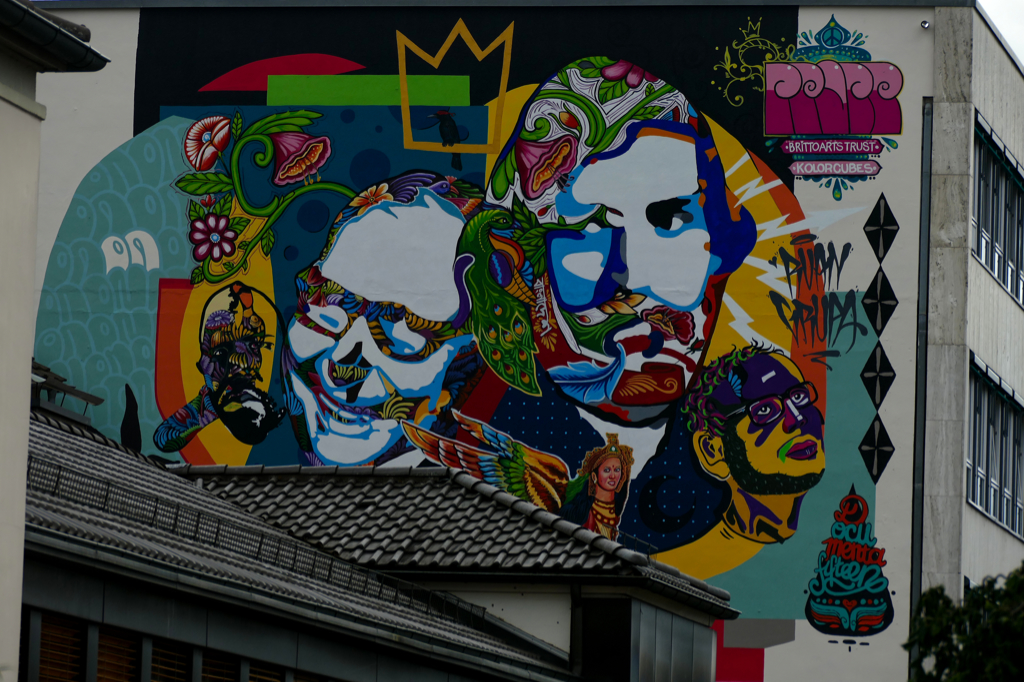
Kassel
From 1277 on, Kassel was the capital of the Landgraviate of Hesse and the Kingdom of Westphalia, to name just two of its ambits. To this date, majestic residences and castles bear witness to Kassel’s glorious past. I’d like to point out the orangery in the so-called Karlsaue and the Wilhelmshöhe Castle in the Bergpark. The latter even made it onto the list of UNESCO World Heritage Sites in 2013.
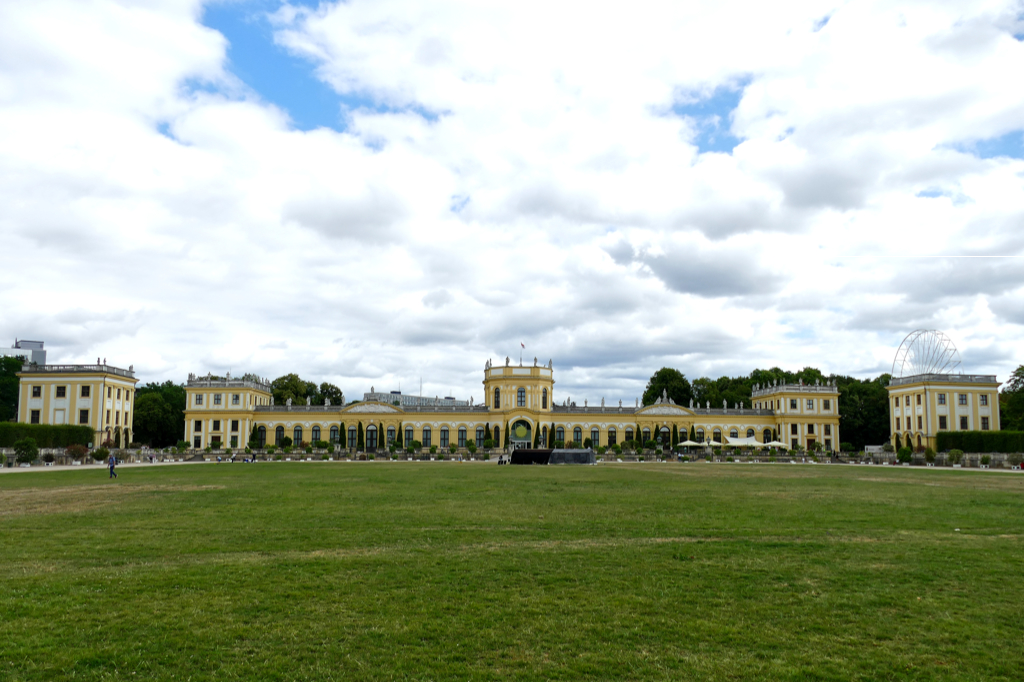
From 1807, Kassel became a center of the German Romanticism movement. Famous poets like Clemens Brentano, Achim von Arnim, and Friedrich Carl von Savigny resided here. Most importantly, the Brothers Jacob and Wilhelm Grimm spent long years in Kassel where they did research on the German language and compiled folk and fairy tales. The first volume was published in Kassel in 1812.
Finally, with the documenta, the city has become world-famous for contemporary art in 1955.
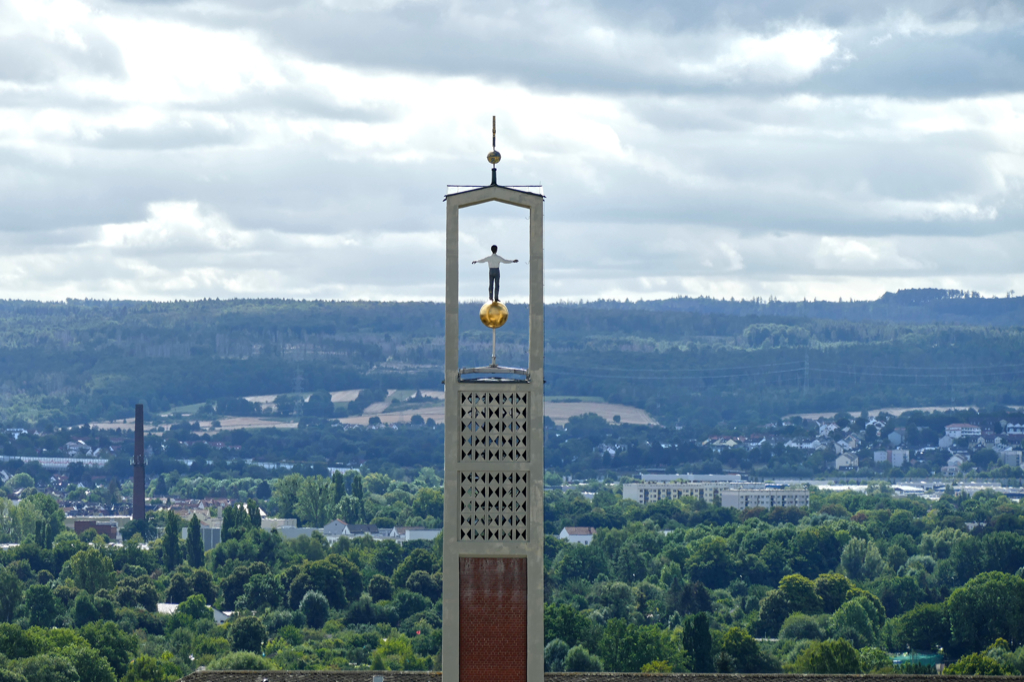
Today, apart from some imposing baroque buildings and huge lush gardens, Kassel has some really pleasant neighborhoods. This year, you’ll have the chance to discover some of them on your art hunt across the city.
Museum of 100 Days
It’s thanks to Arnold Bode that every five years, Kassel gets kissed by the arts and glitters for a hundred days.
Bode, born in Kassel in 1900, studied art in his hometown. As a member of the Kassel secession, he organized his first international art exhibitions in the 1920s. Ten years after WWII, he curated the first documenta in 1955.
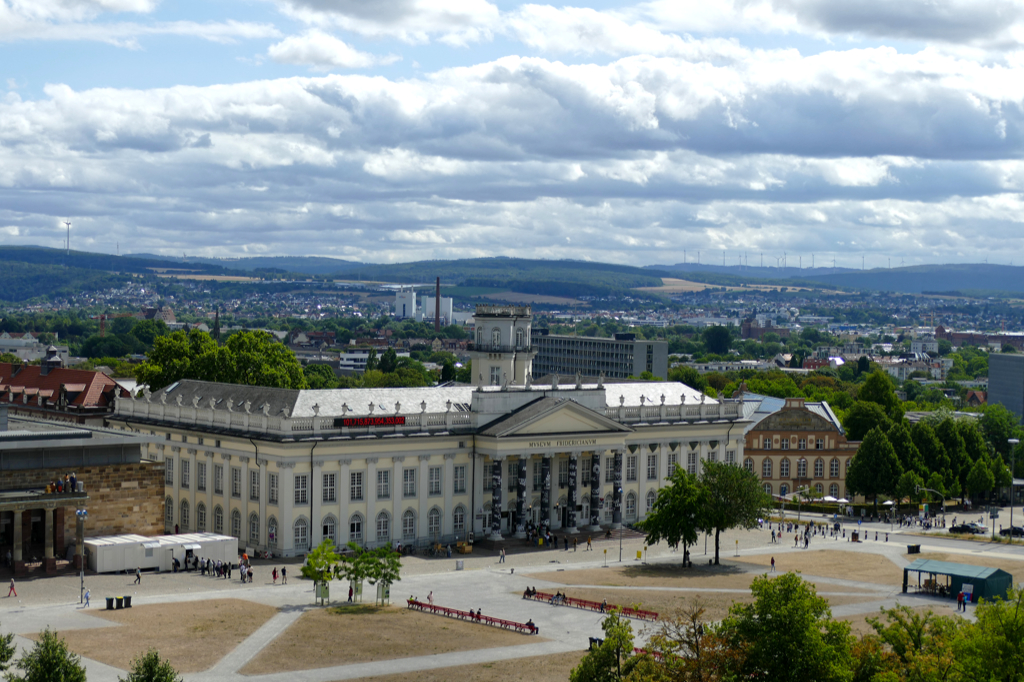
The purpose of this art show was a rather political one. His intention was to introduce works and artists that were vilified by the Nazis as “degenerated”. Therefore, the main focus was abstract art from the 1920s and the 1930s.
Bode co-curated the first four editions. From the fifth edition on, every documenta has been curated by a different director. Therefore, the individual issues have very singular and varied focuses and social and political impacts.
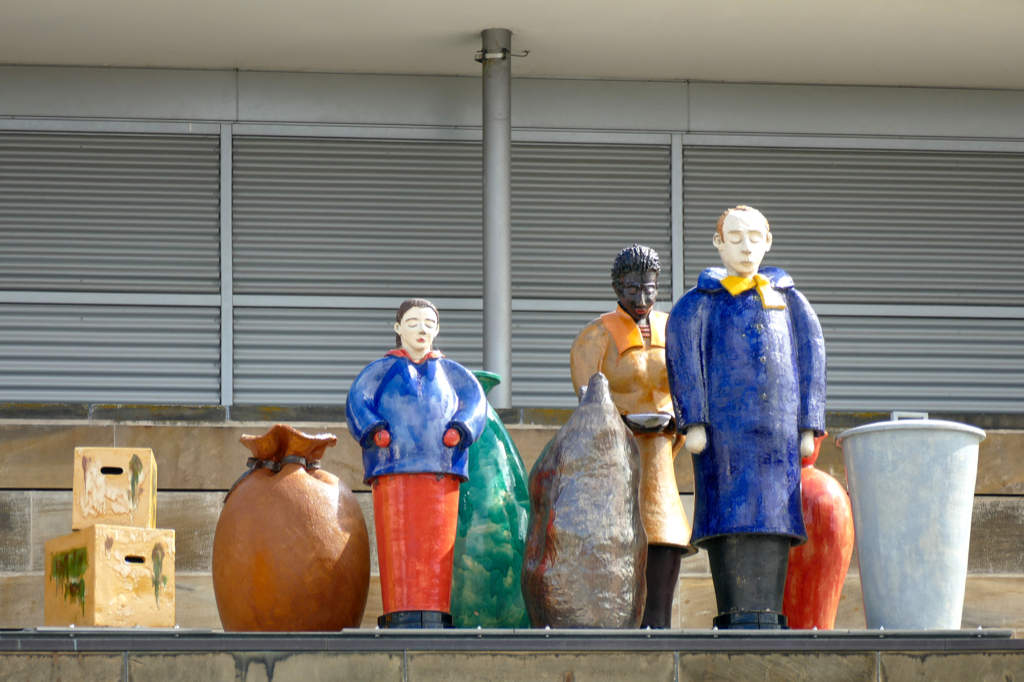
To this date, the documenta is one of the world’s most important exhibitions of contemporary art. Due to its duration, it’s also called the museum of 100 days. It’s taking place every five years at various and very different venues around the city.
documenta 15
This year, the 15th documenta is being curated by the Jakarta-based artists’ collective ruangrupa. This group consists of about ten artists and was founded in 2000. They promote and develop artistic ideas for exhibitions, workshops, and festivals. In the past, they participated in the Gwangju Biennial in South Korea, in the Istanbul Biennial, the Asia Pacific Triennial of Contemporary Art at Queensland Art Gallery in Brisbane, the Singapore Biennial as well as the São Paulo Biennale, to name just the most important ones.
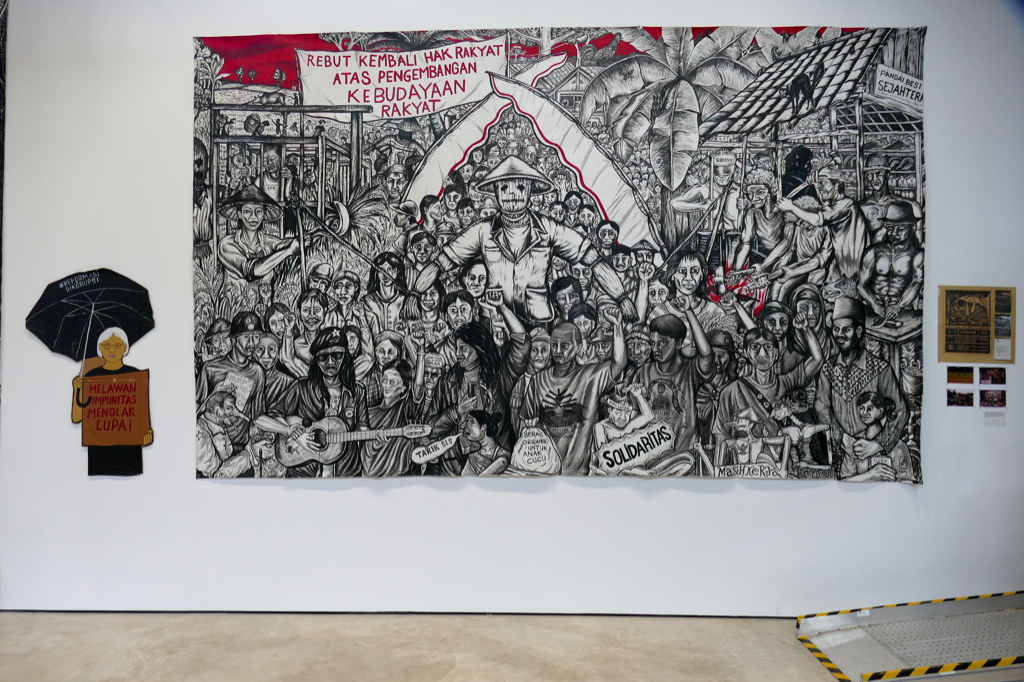
The reason for the documenta committee to choose ruangrupa was that this collective has proven its ability to address myriad target groups already in the past. Consequently, the concept of this year’s documenta is in no way l’art pour l’art. On the contrary. There are all kinds of participative workshops, there is much room for encounters and exploration. It’s actually more a festival than an art show.
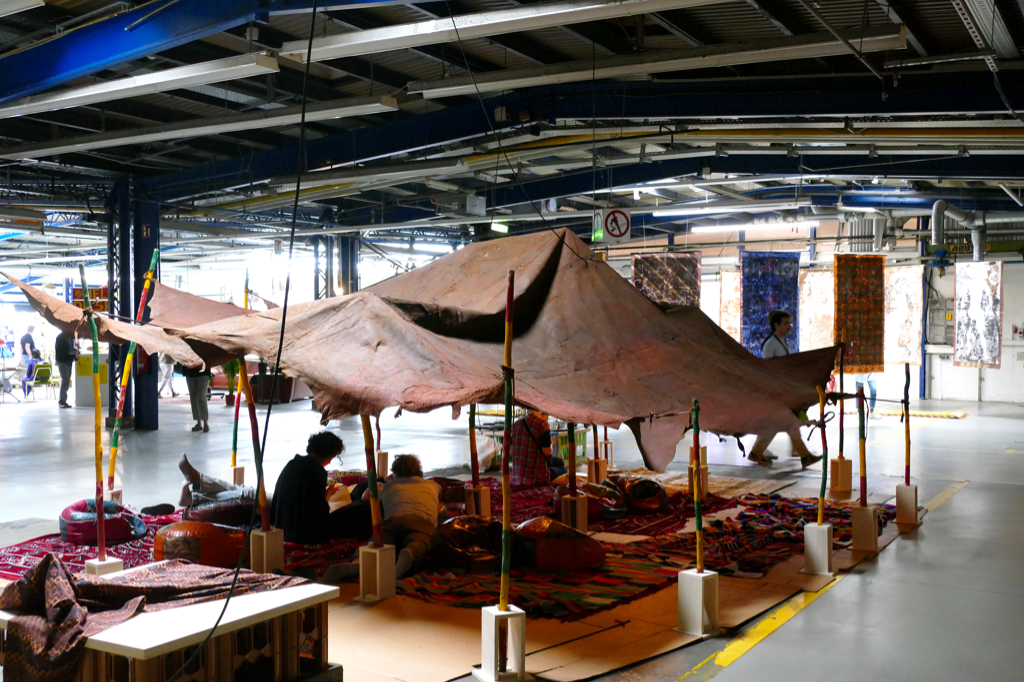
I do like to participate and play a role in the arts. This being said, I’d like to emphasize that mine is the role of a silent admirer. In the arts, I’m a bystander and let the pros do their job.
Amaze me, surprise me, amuse me, or shock me. But please, don’t make me express myself with the help of finger paint.
For my liking, there is a bit too much sociology and ecology and too little art.
Two Inspiring Days
Nevertheless, it was an inspiring visit to Kassel, hence, I’m introducing what I liked best. During two whole days, I managed to pay all venues a visit. However, I did not partake in any of the creative activities, and in the evening, I was exhausted and went to bed early. If you intend to spend hours at each venue and want to join some of the evening activities, your itinerary will be very different.
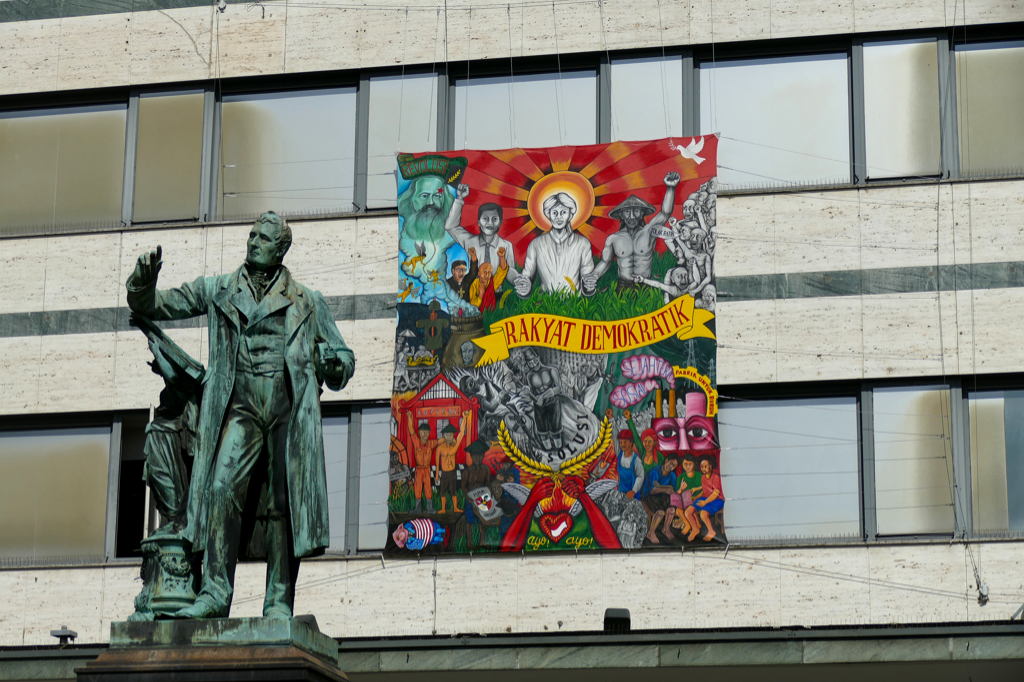
Of all the venues I visited, I’m introducing those that I liked the best. Yet, you’ll find the complete list on the documenta’s website. There are 32 spots in total.
Since I’m not introducing all venues but only my favorite ones, I am able to divide the visit into two parts – the city center west of the river Fulda and the neighborhoods on the east bank.
Venues West of the Fulda
ruru House
If you haven’t bought your ticket online, the ruru House should be your first stop. It’s just a short walk from Kassel’s Hauptbahnhof. At this welcome center, you get tickets and information. Make sure to pick up one of the free maps as well as their small guidebook. Especially the map is very well made and will be very helpful.
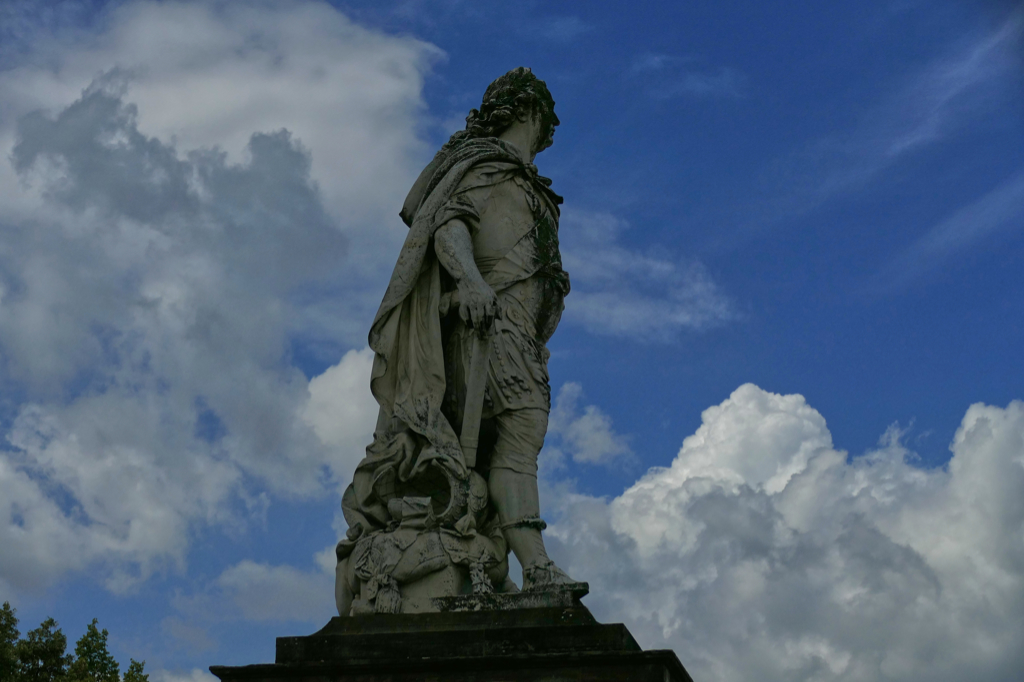
Albeit, the first and most traditional venues are just across the road around the majestic square Friedrichsplatz. The Friedrichsplatz is actually one of the largest inner-city squares in all of Germany. It was constructed in the 18th century during the expansion of the residential city of Kassel and is named after Landgrave Friedrich II of Hesse-Kassel.
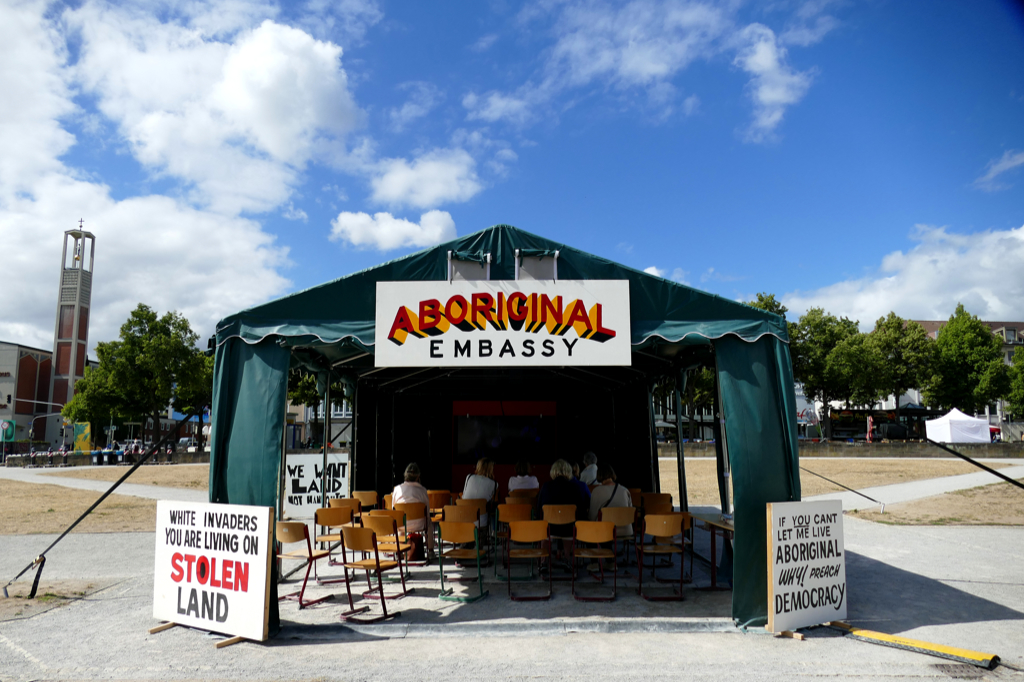
Normally, there is one featured piece located prominently in the square. This year, however, there was a political hiccup so that the major piece by the Indonesian artist collective Taring Padi had to be dismantled.
FRIDERICIANUM
All the significant buildings are on the square’s east side. So let’s begin the visit at the famous art museum Fridericianum.
The building was completed in 1779. It was one of the first public museums on the European continent. It housed the art objects collected by the Hessian landgraves as well as the princely library. From 1810 to 1813, during the Kingdom of Westphalia, the Fridericianum was the palace of the estates and housed the parliament hall.

Today, the Fridericianum is a venue for contemporary art. During the documenta, it is one of the most significant galleries.
ruangrupa sees the building as a lumbung which is Indonesian for communal and sharing. The Gudskul collective from Indonesia, of which ruangrupa is a founding member, is hosting workshops, seminars, and even karaoke nights. They also installed a dormitory and a kitchen on the ground floor of the building. Hence, it’s not an exhibition but a happening – basically, everything I despise. For myself, not for others.
Therefore, I made it quickly to the upper floors where there’s art which is far more down my personal alley.
OFF Biennale Budapest presenting Roma MoMA
In 2015, the OFF Biennale Budapest was founded as a grassroots movement to strengthen the art scene in Hungary.

In the Fridericianum, they present works by the European Roma Institute for Arts and Culture, cleverly titled RomaMoMA.
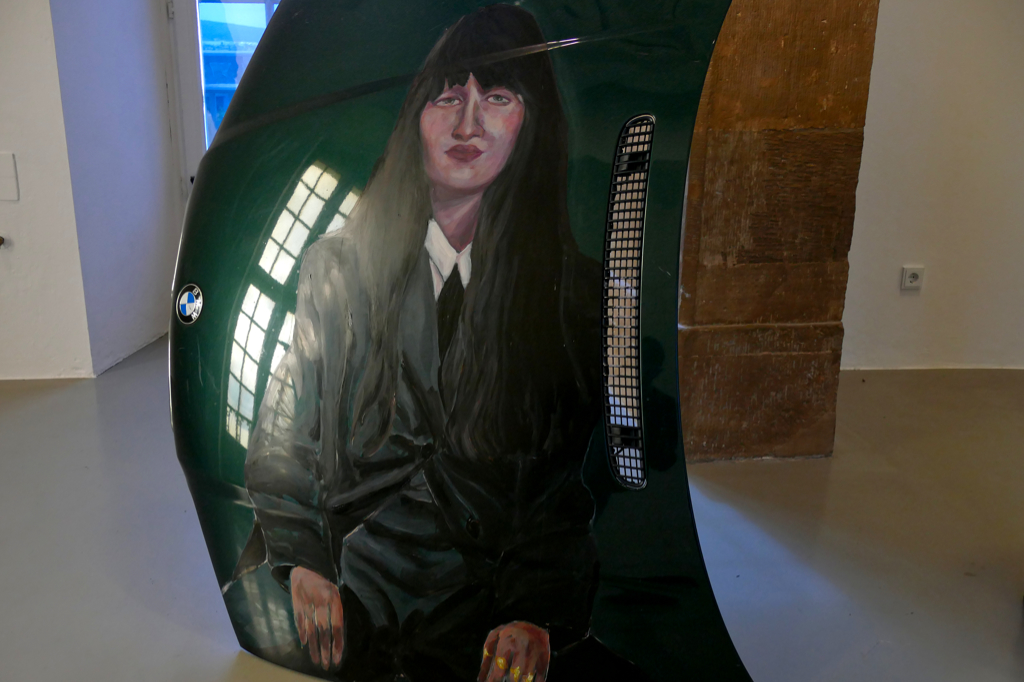
I find it very interesting – and about time – that the ethnic group of the Roma people moves more into focus. Obviously, I’m not the only one since I’ve seen various works at the Biennale di Arte in Venice this year – and now at the documenta, too.

In case you wonder that I’m introducing two works by non-Roma artists: The curating collectives invited different suiting artists to participate in their individual projects.
Richard Bell
You can see Richard Bell’s Embassy Tent which has existed for 50 years now in the picture above. However, he also contributed some of his paintings with clear messages in bold colors that I like a lot.
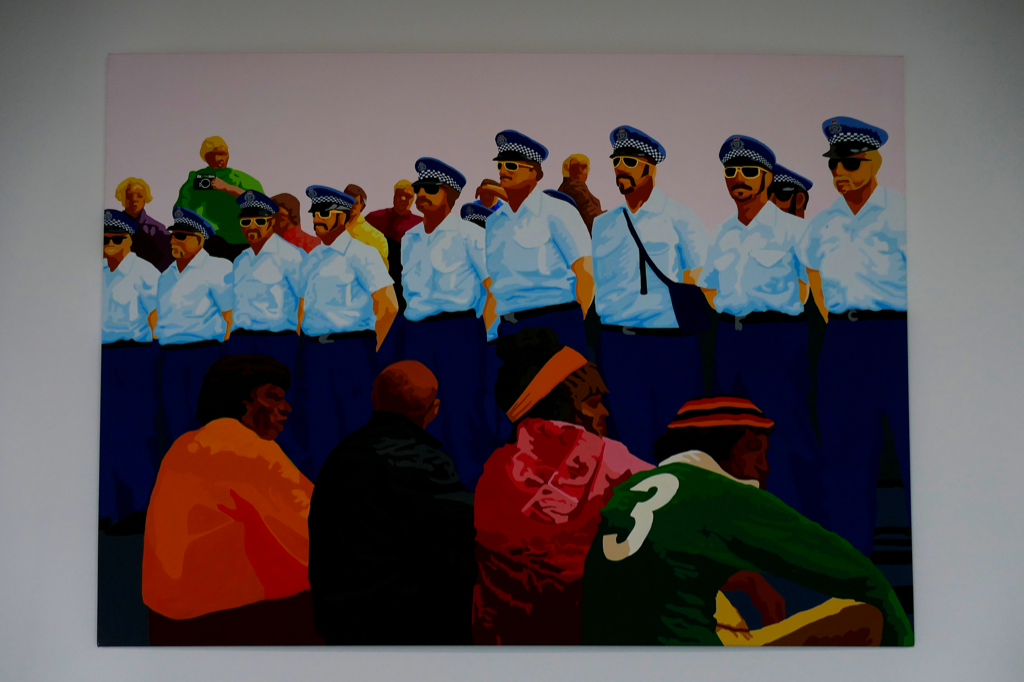
Richard Bell is an Aborigine of the Kamilaroi tribe, born in Queensland, Australia, in 1953. He is a political artist and activist for Aboriginal rights, obviously.

Besides these works, there are many more project at the Fridericianum such as wie The Black Archives, Asia Art Archive, Archives des luttes des femmes en Algérie, and Siwa plateforme – L’Economat at Redeyef.
Natural History Museum at the OTTONEUM
Just across the road from the Fridericianum is the Ottoneum. In the 17th century, it was Germany’s first permanent theater building. Today, it houses the natural history museum where you get to see the so-called Goethe elephant. This poor creature – I’m referring to the elephant, obviously – lived in the landgrave’s menagerie in the Karlsaue.
During the documenta, the South Korean collective ikkibawiKrrr experiments with seaweed, exploring its use as food but also to manufacture weapons.

The Spanish collective INLAND introduces its educational projects such as the Cheese Pavilion of the local bio-project Schmackes and their collaborations with the Fundación Marso which is supporting the Rarámuri weaver and shepherds in northern Mexico or with the beekeeper Michael Hertweck sustaining his project Bee Flag in Kassel.
documenta HALLE
The documenta HALLE is just a few steps from the Ottoneaum. It stands right next to the theater building by Ernst Brundig and Paul Bode. The latter was the brother of the documenta inventor Arnold Bode, by the way. The postmodern-constructivist design of the documenta HALLE shows elements of cubism and shall complement the theater building.

This year, you enter the venue through a tunnel simulating an African hut. It was created by the Wajukuu Art Project from Nairobi.
The Instituto de Artivismo Hannah Arendt, in short INSTAR, from Havana, introduces various Cuban artists that fell from the Gran Líder’s grace.
Britto Arts Trust
The lower level of the documenta Halle is dominated by a bold painting. Fourteen contemporary artists teamed up with a cinema banner painter and a rickshaw painter to create a mural based on a month-long research project in which films political and social topics were viewed and discussed.
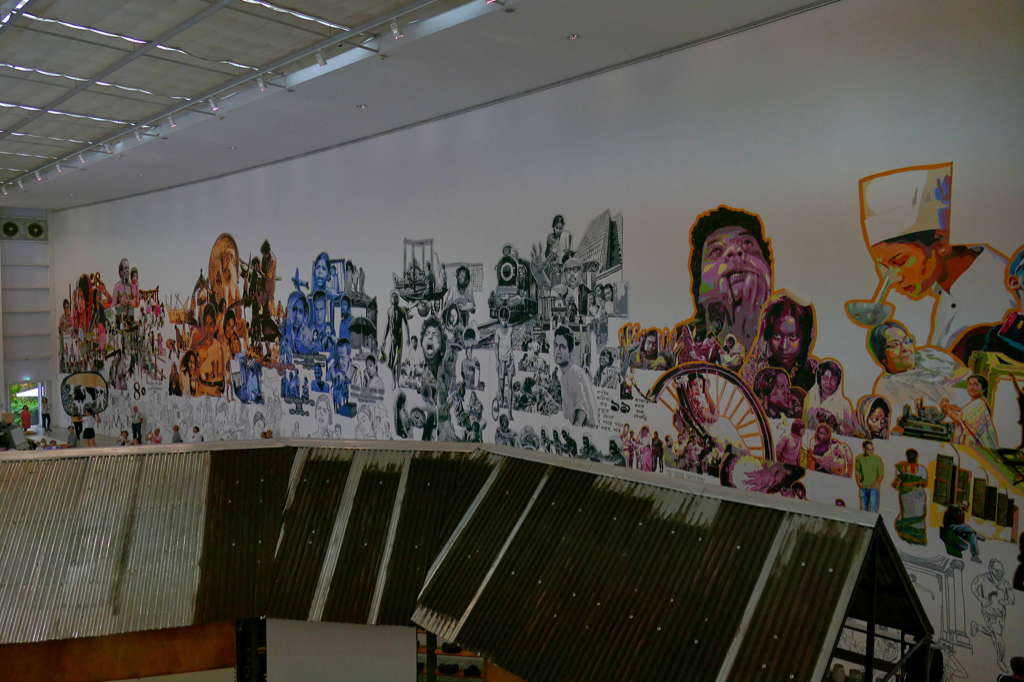
The seven films which were chosen for the mural contain strong statements and stem from different time periods that are historically linked to India and Bangladesh.
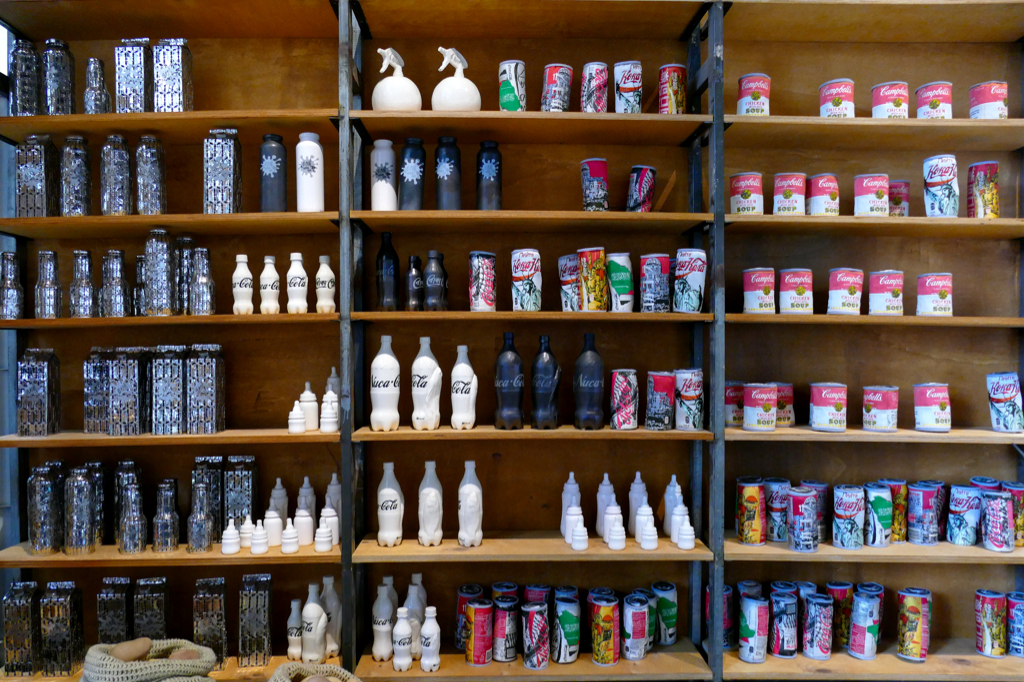
The Britto Arts Trust’s installation rasad – which translates to ration – is an elaborate take on a bazaar. A variety of manufactured foods such as eggs, milk, vegetables, and potatoes are set up on shelves and in a pantry. These artificial foods are made from different materials such as ceramics, plaster, plastic, cotton, and corrugated iron.

They are intended to make the viewer think about the connection between the international food trade, the legacy of colonialism, the slave trade, and ongoing exploitation.
Baan Noorg Collaborative Arts and Culture
The non-profit artists’ initiative Baan Noorg Collaborative Arts and Culture developed strategies for communities and supports artistic practices.
Their contribution to this documenta consists of three elements. Firstly, they set up an exchange program for a small dairy farm in Kassel and one in Nongpho in Thailand. In 4-channel videos, you can watch a documentary from both homesteads.
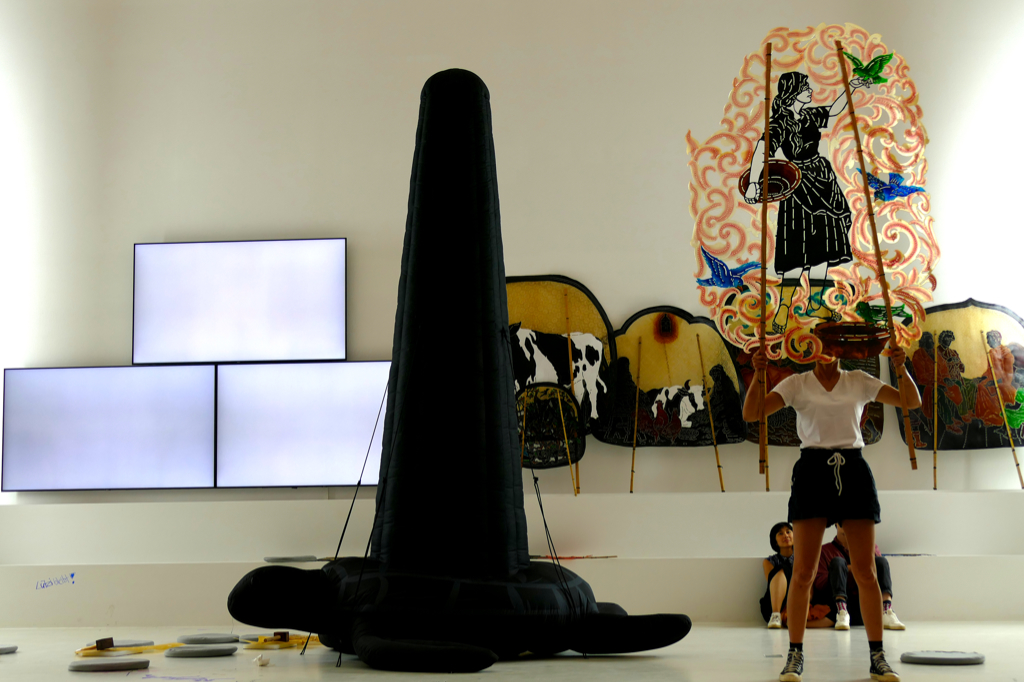
Above a small skateboard ramp, they perform a Nang Yai, hence, a traditional Thai shadow play. The beautifully crafted silhouettes depict gods and characters from the Ramayana epic. To honor Kassel, a city famous for the brothers Grimm, there are also characters from their German fairy tales. Also, visitors can try out how to make such a silhouette right on the stage by hammering holes into a very sturdy material.

Those who prefer breaking their legs than smashing their fingers can do so on the skateboard ramp below the stage.
Karlsaue
The large Karlsaue State Park starts right behind the documenta HALLE. The baroque greenery was named after Landgrave Karl von Hessen-Kassel and has actually been an important location for the documenta for many years now.
On the lawn in front of the beautiful Orangery, bales of fabric are piled up to form a walk-in installation. Inside, a gentleman in a smart suit explains in a video: “Clothes are an expression of dignity”. Consequently, sending used clothing as a handout to African countries is the opposite.

Sadly, the industrialized north has dumped all kind of trash in African countries without offering a sustainable solution.
The Nest Collective, an art group from Kenya, brought bolts of fabric, electronic and plastic waste to Kassel. Cleverly, their installation is called Return To Sender.
Hessian State Museum
Celebrating the thousand-year anniversary of the city of Kassel, the Hessian State Museum was inaugurated in 1913. The architect’s historicizing design was based on Hessian architectural monuments of the late Renaissance.
Today, the museum houses over 6000 objects from the collections of prehistory and early history as well as applied arts.
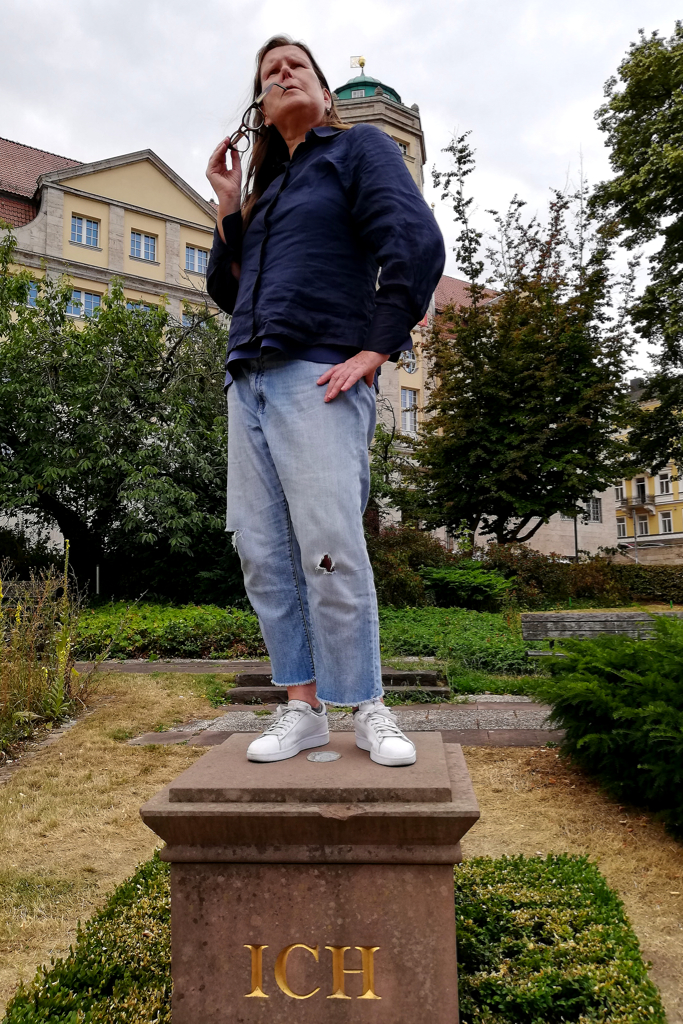
On the occasion of the documenta, Berlin-based artist Pınar Öğrenci is screening a film on oppression in Müküs her father’s home village in the Turkish province of Van. Also, there is an installation of hand-sewn paper towels made by women from the province that the artist had to flee herself in 2015.
FAFSWAG collective
On the second floor opens the majestic hall of the coat of arms. Here, the FAFSWAG collective is showing an installation including a digital sculpture. As visitors walk around a pillar, a ghostly dancer appears on their iPad and they listen to mysterious words.
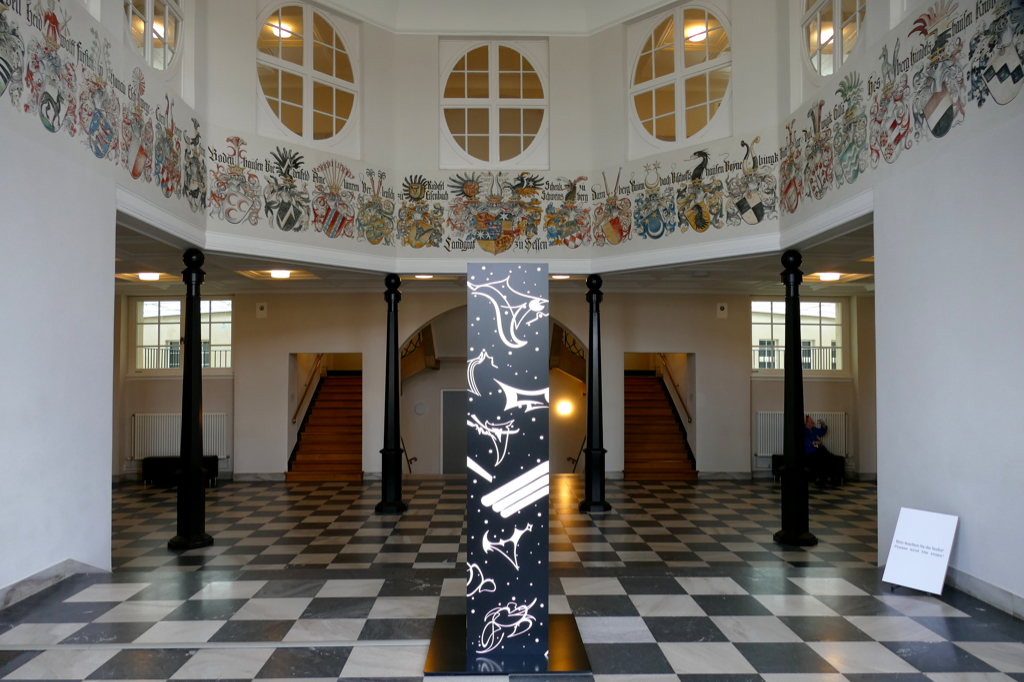
The collective was founded in Aotearoa in 2013. They promote queer, indigenous artists in a wide variety of genres in contemporary Pacific art. The collective creates experiences that refer to their unique as well as diverse contexts as LGBTQ artists from Oceania.

Obviously, the FAFSWAG collective immediately reminded me of one of my favorite pieces at this year’s Biennale di Arte in Venice, namely Sāmoan-Japanese artist Yuki Kihara who designed the pavilion of New Zealand and introduces the Fa’afafine, Sāmoa’s so-called third gender.
Finally, diversity becomes a thing everywhere.
GRIMMwelt
The Grimmwelt explicitly does not claim to be a museum but rather a walk-in sculpture. Here, visitors can get literally lost in a labyrinth of the German language. This is important to know since the brothers Grimm mainly stand for their important compilation of fairy tales. However, this is only a small aspect of the exhibitions.

If you don’t speak any Germany at all, you probably won’t be able to enjoy the Grimmwelt in its entire ingeniosity. On the other hand, if you have a thing for linguistics and are familiar with the German tongue, you’ll have an intellectual blast.
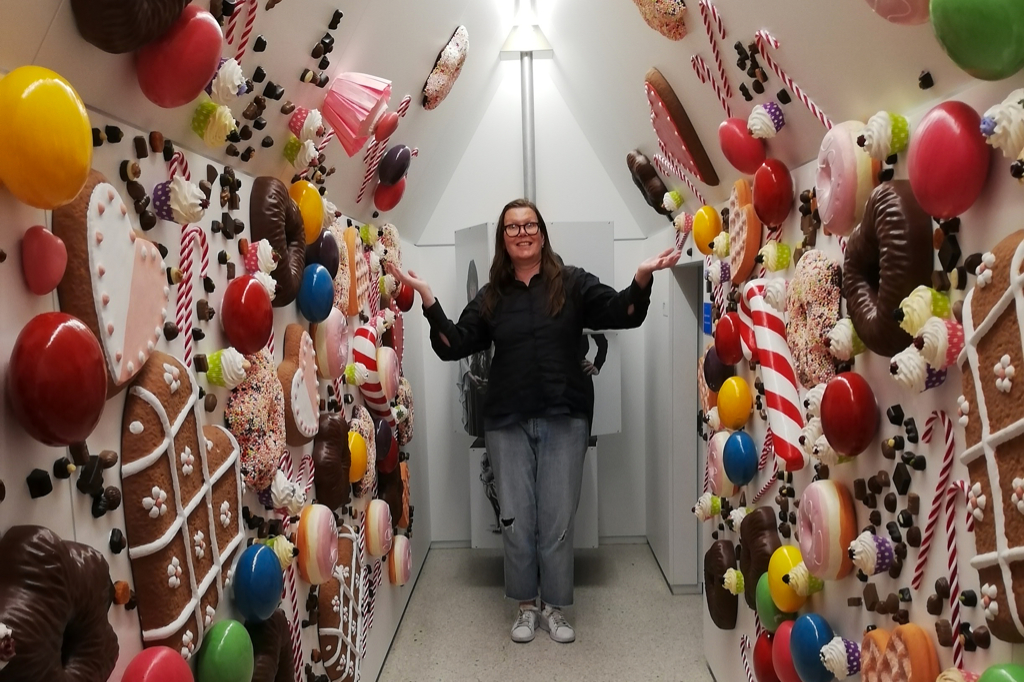
But this year, the Grimmwelt made space for two of the documenta’s major installations so that you have the chance to sneak-peek and check out how far the permanent exhibition is for you.
Agus Nur Amal PMTOH
Nevertheless, I’m sure that the installation by Agus Nur Amal PMTOH, a storyteller from Aceh in Indonesia, will take every visitor by storm.
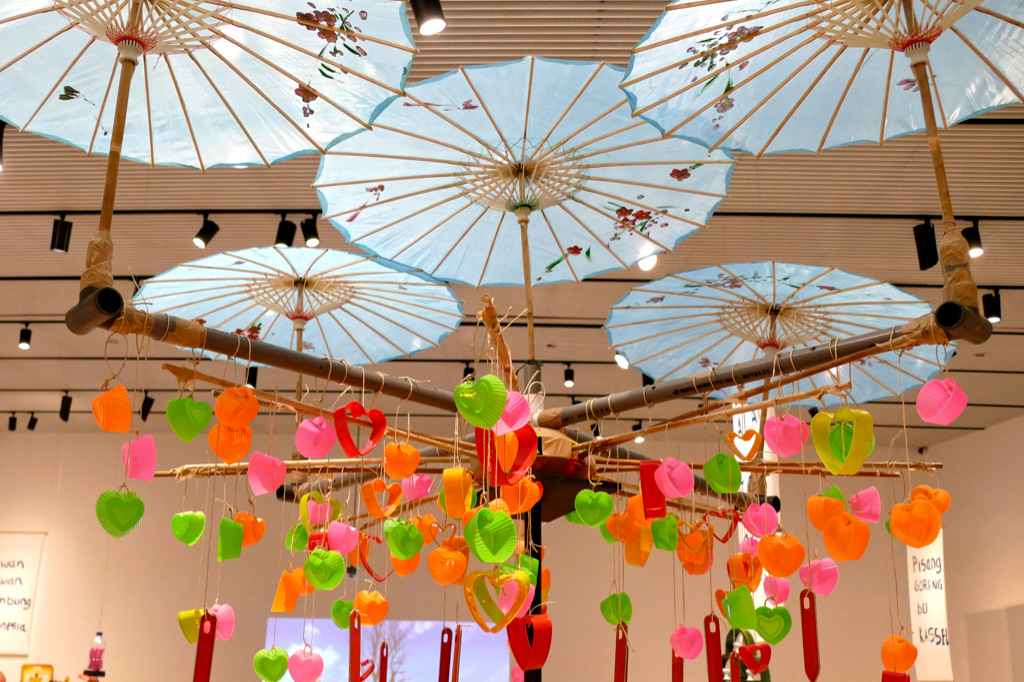
In his installation, he uses everyday objects to reach and stimulate the visitors’ imagination. The cheap colorful plastic crap that he combines in fun installations can represent sceneries as well as human actions. He intends to invite the viewers into the spiritual world and give them a happy feeling.
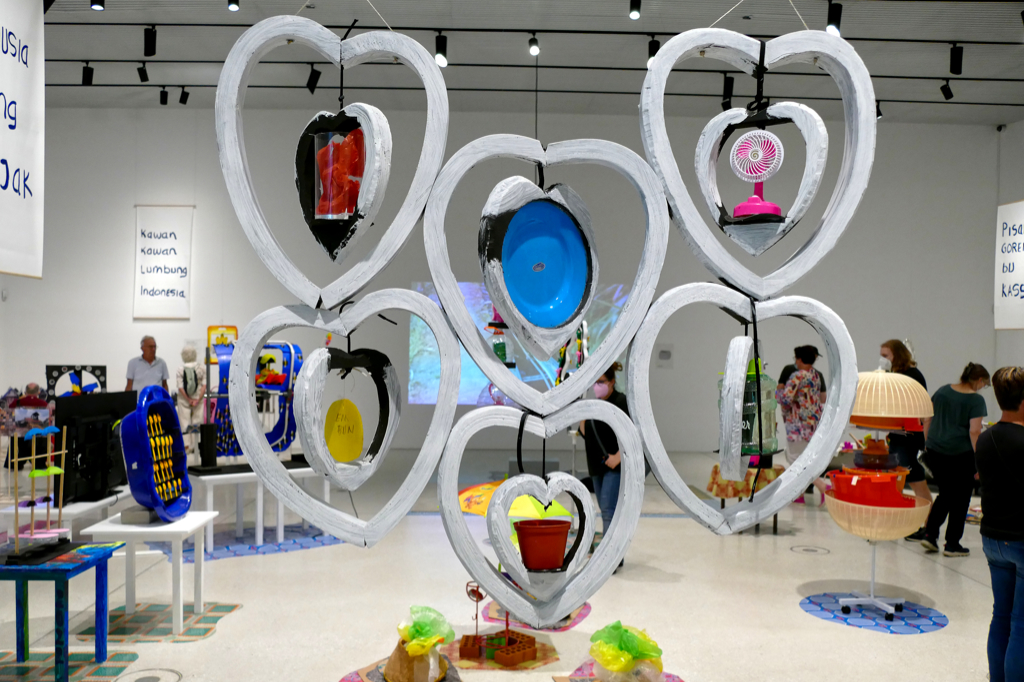
This way, the professional storyteller preserves and revitalizes the Indonesian tradition of storytelling called hikayat.
Museum for Sepulchral Culture
Just a few steps from the Grimmwelt is another very quirky museum. Kassel’s Museum for Sepulchral Culture opened in 1992. It is dedicated to topics related to dying, death, burial, mourning, and remembrance, obviously. The permanent exhibition covers customs and traditions from the Middle Ages to the present day. Apart from information and explanations, you’ll find tombstones and sculptures, coffins and hearses, as well as mourning attires.
I was very curious to visit this truly unique museum. But to be honest, the two documenta features didn’t impress me much. However, I was amazed by the so-called Breadheads by Harry Kramer which are part of the permanent collection.
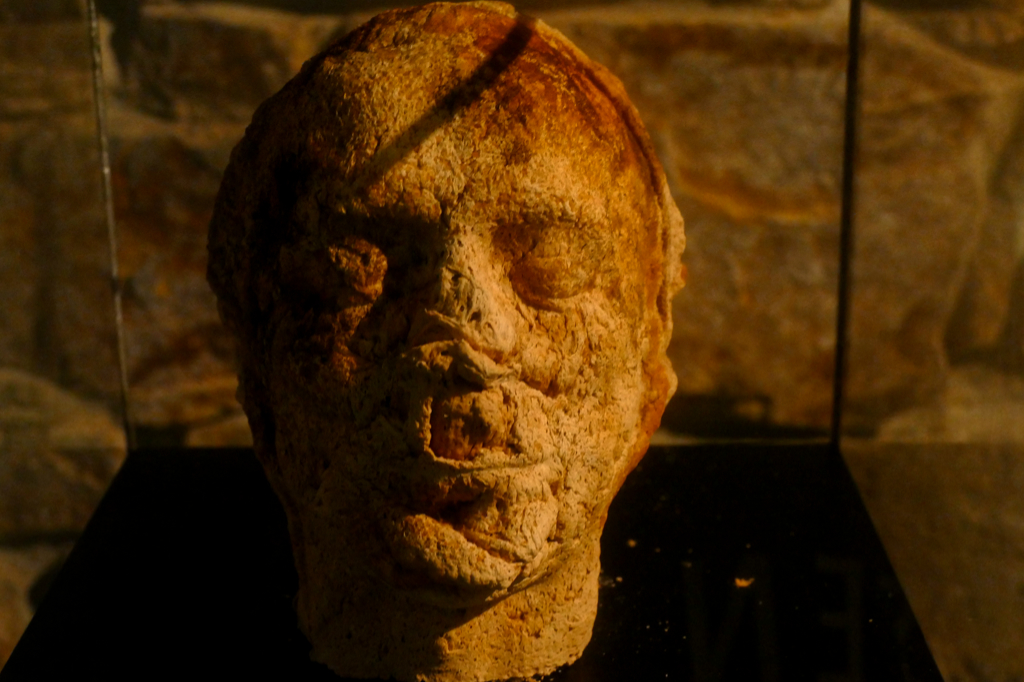
Harry Kramer was a German dancer, artist, and professor of sculpture at the Kassel Art Academy. He was internationally known for his kinetic art. In 1964, he participated in the documenta III.
His busts made of moldy bread are a graphic symbol of transience. Four years after this project, he also came up with the idea of setting up an artists’ cemetery in Kassel which you can visit to this date.
City Museum
Kassel’s city museum focuses on the development of the city between the 18th and 20th centuries.
During the documenta, artist collectives aiming at the representation of a marginalized minority are showing their work on each of the museum’s four floors.
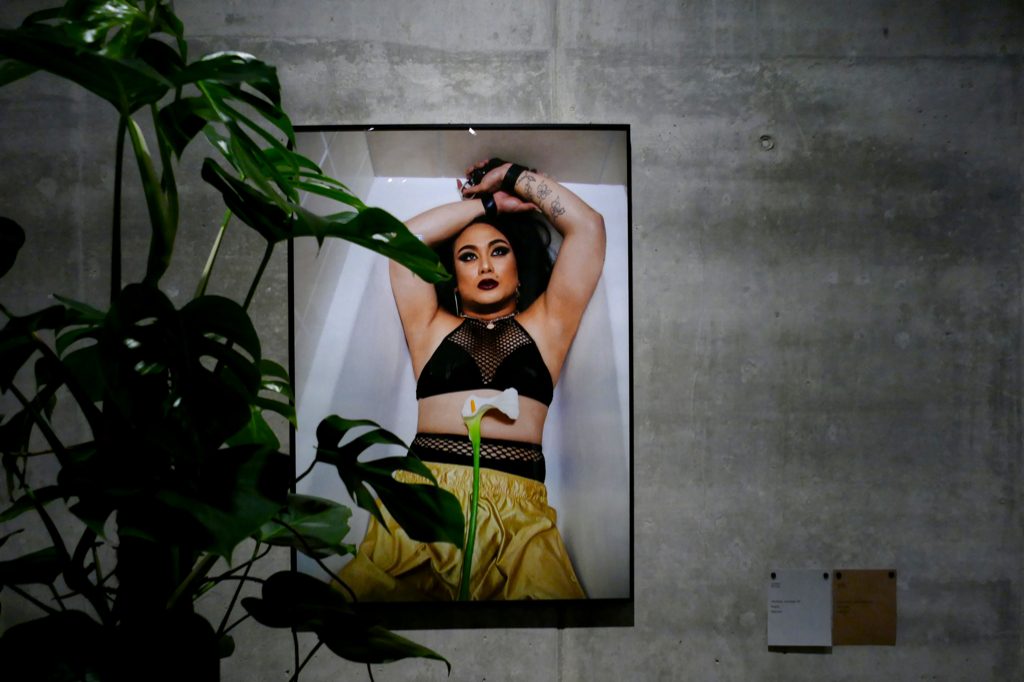
The British Project Art Works deals with neurological diversity and supports artists with special needs whose works will eventually be shown at the Fridericianum.
The Nhà Sàn Collective from the Vietnamese capital Hanoi created an installation pretending to set sail from a Vietnamese port.
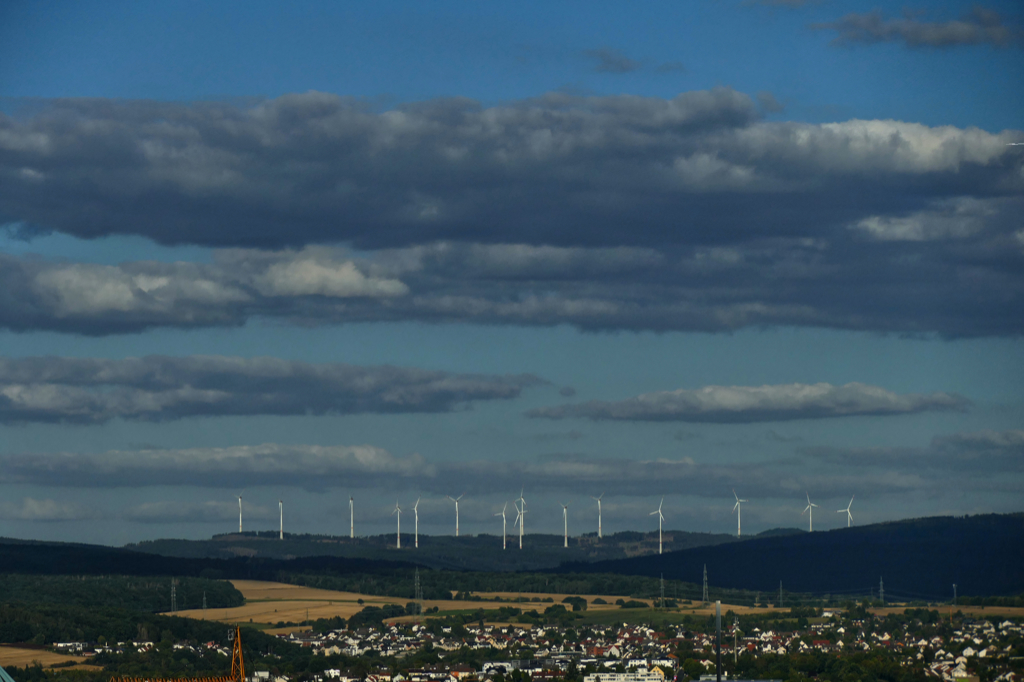
Sidney-based artist and activist Safdar Ahmed present a video installation and other pieces based on the experiences of refugees.
Last not least, the FAFSWAG collective that I’ve already introduced above shows videos and photos of people from the LGBTQ community in the Pacific region.
WH22
WH22 stands for Werner-Hilpert-Strasse 22. The building complex housed the popular club A.R.M. and the Lolita Bar. The latter still exists and opened its beer garden in the courtyard on the occasion of the documenta.
In these run-down structures, various art collectives are introducing their work. There are the groups Alice Yard from Trinidad and Tobago and LE 18 from Morocco as well as the Nhà Sàn Collective from Vietnam.
My favorite, however, was the exhibition initiated by The Question of Funding from Palestine. They are introducing works by the Gaza-based art collective Eltiga which is Arabic for encounter.
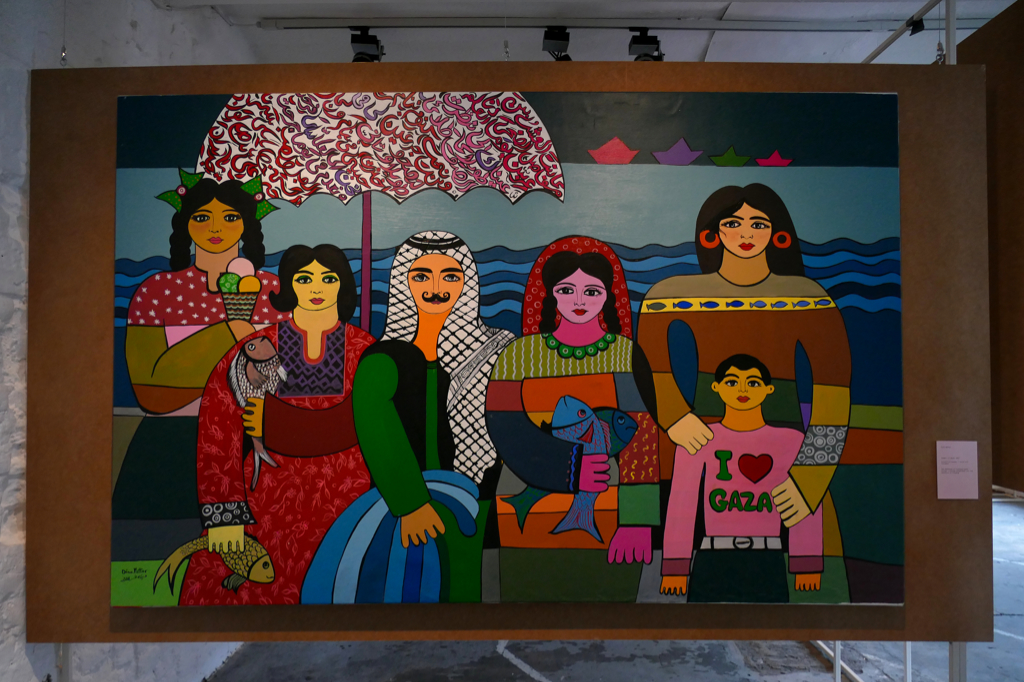
The works on display can be actually acquired and the generated funds will secure Eltiga’s future activities.
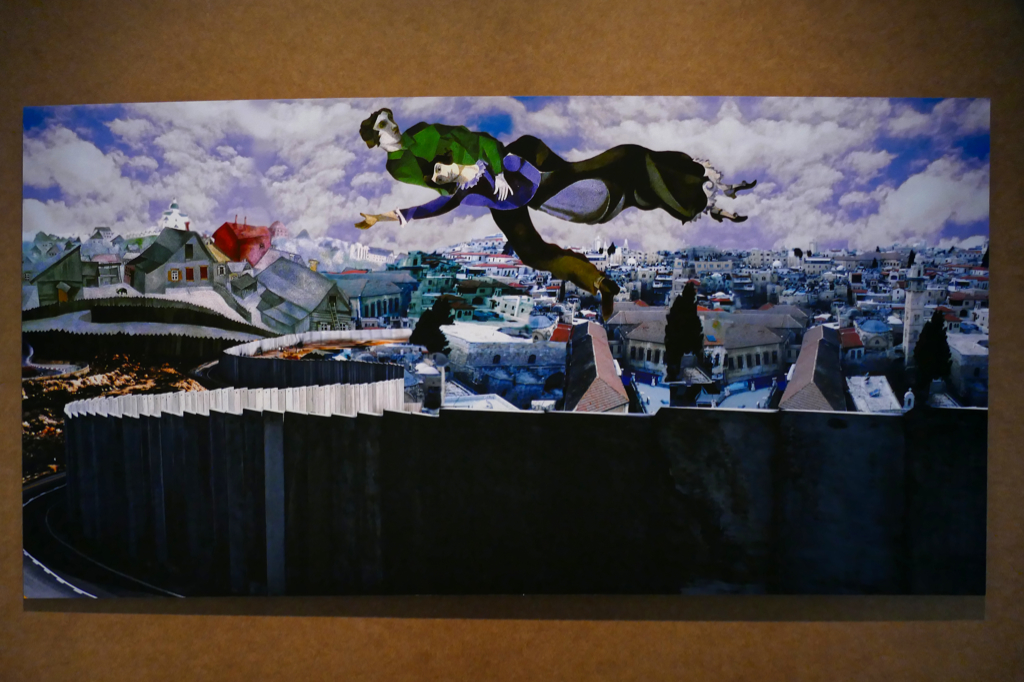
The Question of Funding started its activities with summits in Ramallah. There, a large community of artists was unhappy with their working conditions. Although the members who came from different NGOs were able to form a stable collective, they are permanently struggling financially.
Venues East of the Fulda
Platz der Deutschen Einheit
With the help of the really excellent map that the documenta people are giving out for free, you can navigate through the city even if it’s your first time in Kassel. I mean, even I was able to find my way to all the venues – and I have no sense of orientation whatsoever.
This being said, to begin your visit to the venues on the river Fulda’s eastern bank, just hop on either tram #4 or #8 at the stop Friedrichsplatz and get off at the Platz der Deutschen Einheit.
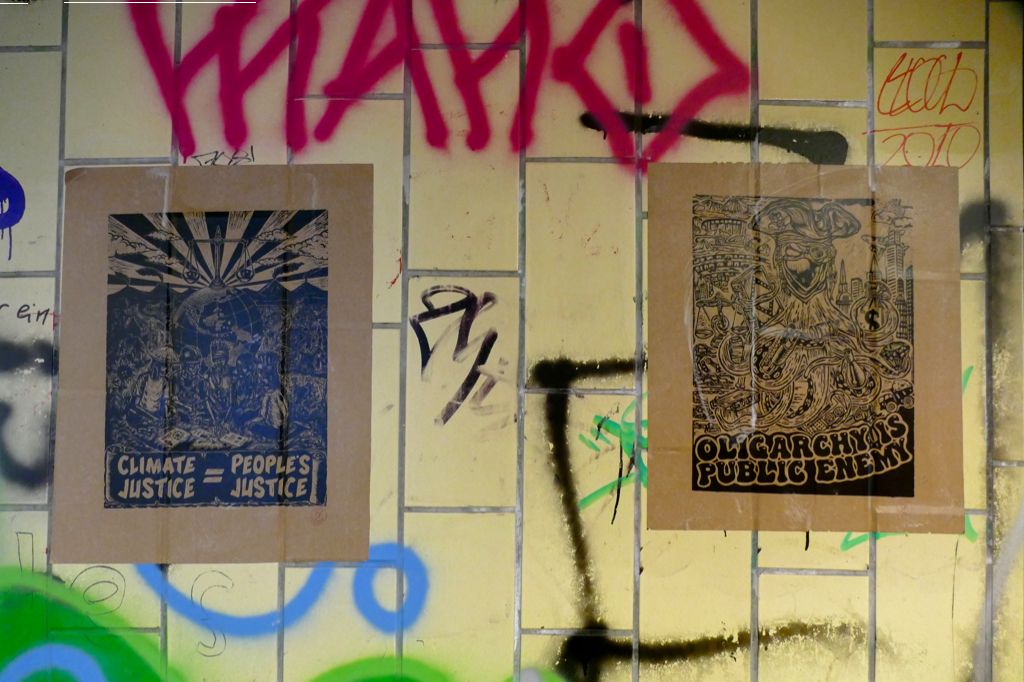
Here, the members of the Danish collective Trampoline House chose the pedestrian underpass for the sound installation The Walls Have Ears. Actually, these walls have rather voices since this acoustic installation by Sudanese artist Khalid Albaih consists of speakers embedded in the walls. From these speakers, asylum seekers are telling you their stories.
The most important part of Trampoline House’s contribution to this year’s documenta, however, is at the Hübner Areal where they deal with different aspects of Denmark’s harsh migration policy.
Hallenbad Ost
One bloc down from the square Platz der Deutschen Einheit is the Hallenbad Ost, a former indoor pool. The building, erected in 1929, is one of Kassel’s very few structures built in the Bauhaus style. Yet, after the public pool was closed down in 2007, it stood empty for over ten years and was almost demolished.
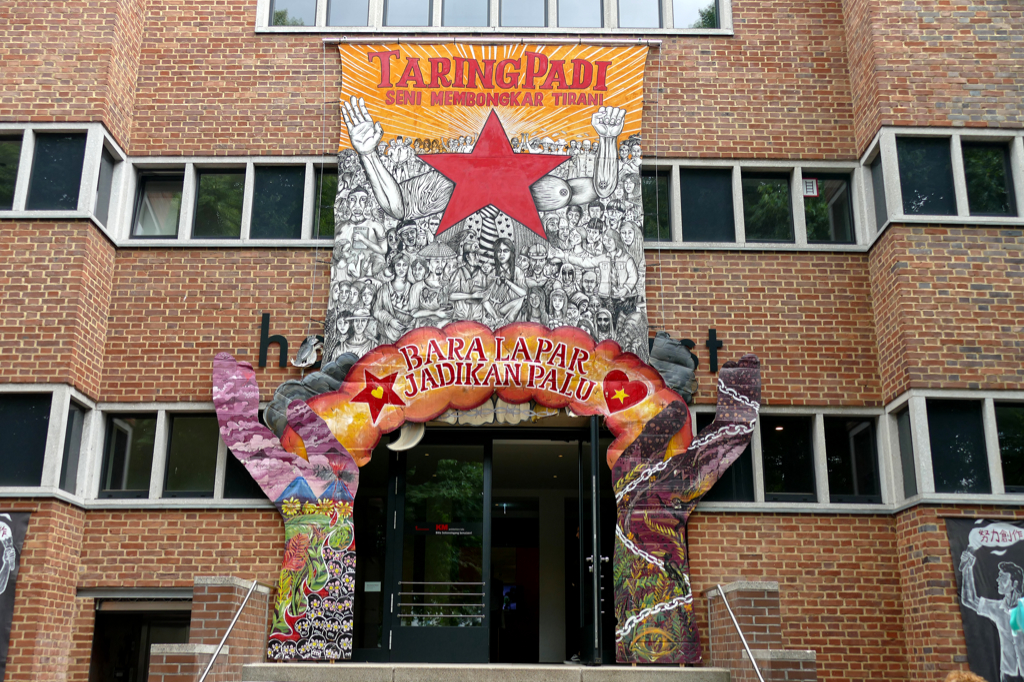
During the documenta, the Indonesian collective Taring Padi presents its work on two floors. The group opposes capitalism, violence, oppression, and discrimination in any shape or form.

On their large-scale banners, posters, and life-size cardboard figures, the so-called wayang kardus, Taring Padi articulate their messages as clear statements. Sugarcoating is definitely not their thing.
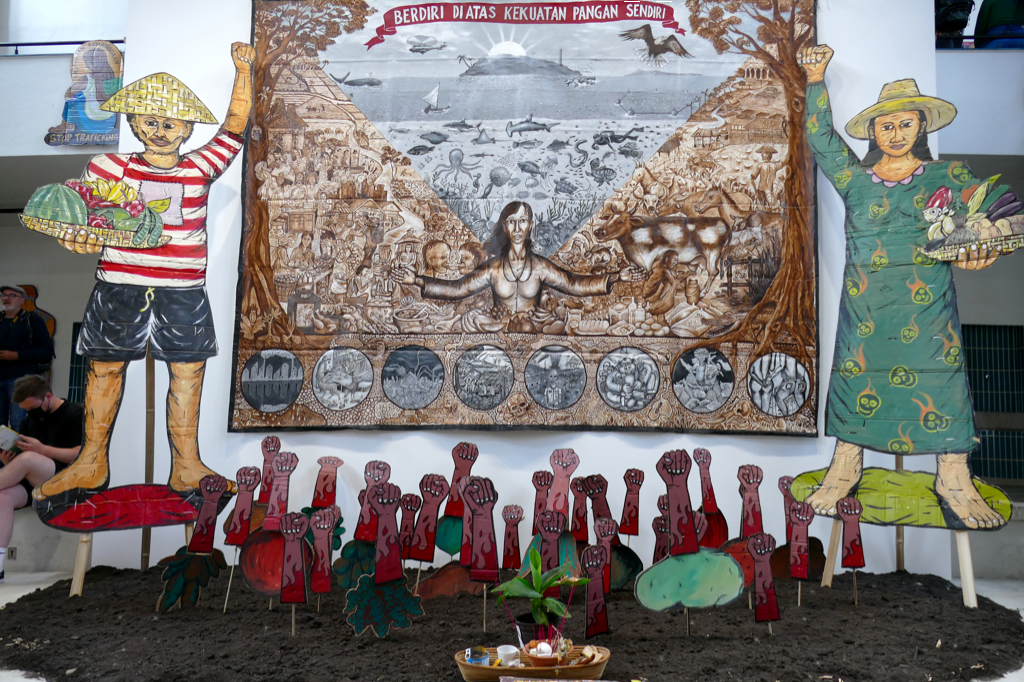
Their show at the Hallenbad Ost is a retrospect of their artistic works from the past 22 years. Sadly, all their political claims are still valid.
St. Kunigundis Church
Another powerful exhibition is taking place at the Roman Catholic Church of St. Kunigundis just minutes from the Hallenbad Ost. Completed in 1927, it is considered the first church to be built with prestressed concrete which makes it quite unique.
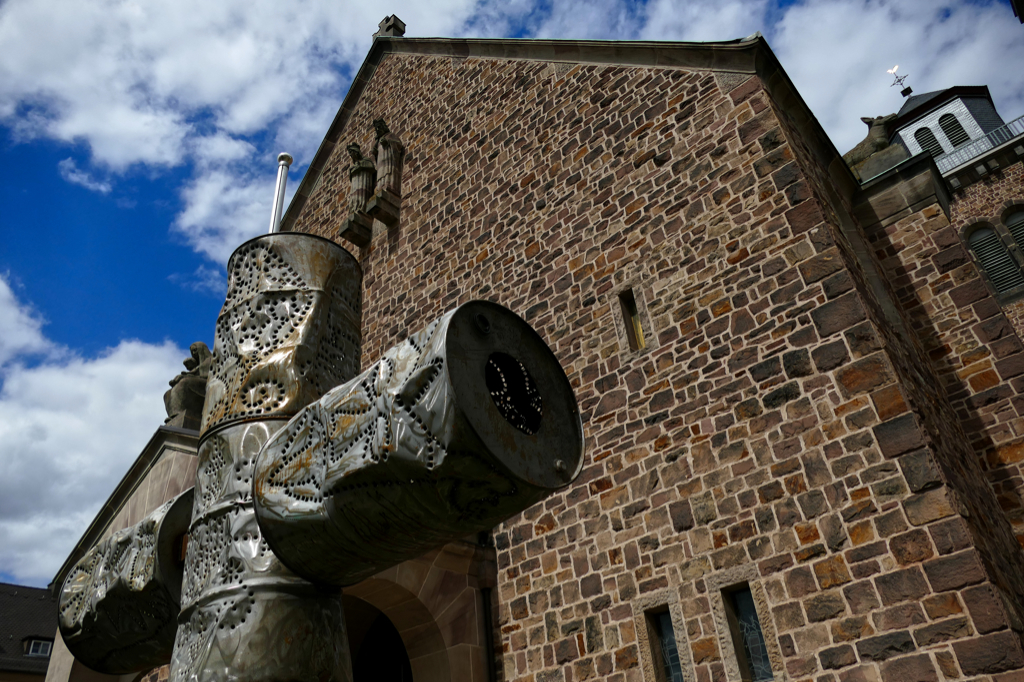
Unique outside, extraordinary inside – this project is definitely one of my favorite contributions to this year’s documenta.
Atis Rezistans, which translates to Artists of Resistance, is a passionate mainly female artists group based in the neighborhood around Grand Rue in Haiti’s capital Port-au-Prince. This group works in sculpture and painting but also in the fields of photography, video, music, slam poetry, smithing, and performance.

In the St. Kunigundis Church, the artists installed some truly disturbing mixed media sculptures. Very voodoo, very Haitian.
In fact, many of the pieces relate to Haitian history and religion. Therefore, Atis Rezistan’s Ghetto Biennale has been very pleased that the Catholic Church has agreed to this exhibition in their house of worship.
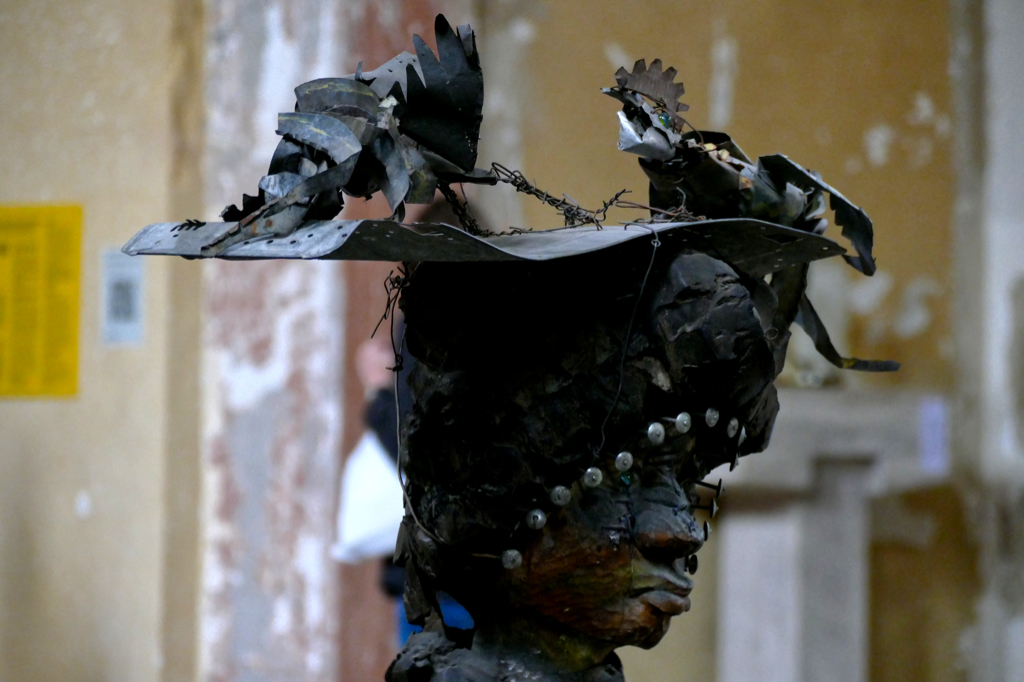
In December 2009, Atis Rezistans hosted the 1st Ghetto Biennale. Over the past twelve years, the group organized exhibitions with more than three hundred international female artists. At this year’s documenta, Atis Rezistans Ghetto Biennale presents examples of those collaborations.
Hübner Areal
The Hübner company produces components for buses and trains. As they recently left their plant on Agathofstraße, the documenta got another suitable site for a great exhibition.
I’ve already mentioned above that there is a very touching installation on Denmark’s migration politics by the group Trampoline House who campaigns for the rights of refugees in Copenhagen.
But there were many more very impressive projects at the Hübner Areal. As a matter of fact, it was definitely one of the venues I liked the most.
Subversive Film
The multinational collective Subversive Film presents 20 films that were hidden in Tokyo for four decades. After meeting a Japanese experimental filmmaker and former member of the Japanese Red Army, Subversive Film acquired this collection together with dozens of movie posters and a vast library. The material was sent in batches from Beirut to Japan between 1967 and 1982.
Now, 20 of those restored films are screened at the Hübner Areal.
Jatiwangi art Factory
Founded in 2005, the Jatiwangi art Factory is a community project for culture and contemporary art.

At the beginning of the 20th century, Jatiwangi was the largest clay mining site in Southeast Asia. Today, the Jatiwangi art Factory uses the exactly same material to build consciousness and identity among the citizens of their region through arts and cultural activities.
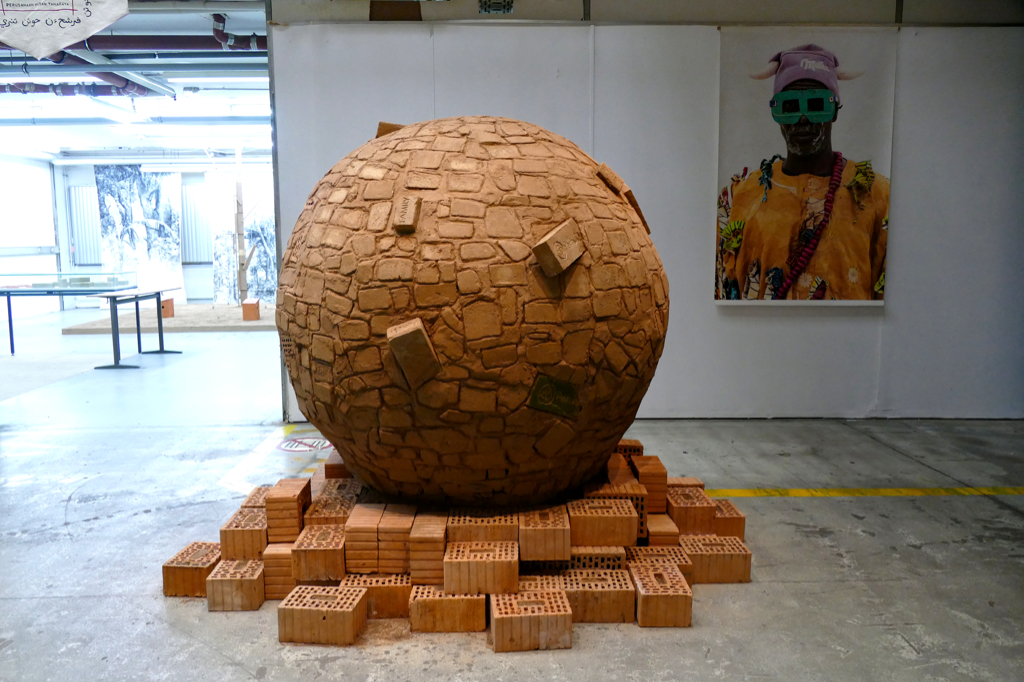
The Fondation Festival sur le Niger
The Fondation Festival sur le Niger from Mali preserves traditions of the Malian culture, like for instance a great sense of hospitality.
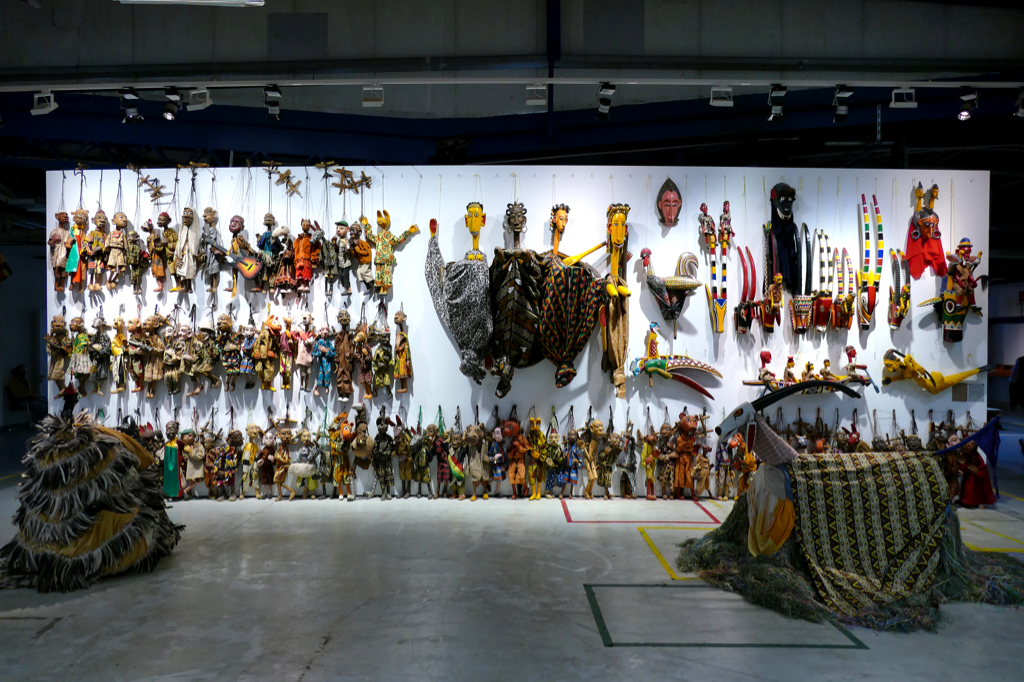
Soon after its start in 2005, the Festival sur le Niger became the most important art event not only in Mali but in all of West Africa. With a comprehensive program of music, dance, theatre as well as visual arts, they support the cultural identity of the Ségou area. This way, they also prevent migration of young artists to the capital Bamako or even abroad.

At the Hübner Areal, the Fondation Festival sur le Niger is introducing a series of artistic acts outlined as Le Maaya Bulon. In Malian architecture, a bulon is some kind of a vestibule where hospitality isbeing practiced; and hospitality is a core value in Malian culture.
Moondog
After all this amazing, deep, conscious, and thought-provoking art I got to the last room and there he was, the Moondog. For the longest time, he had a job as the stage set for a play at the Bochum theater. Now he is retired and a loos a bit mothy.
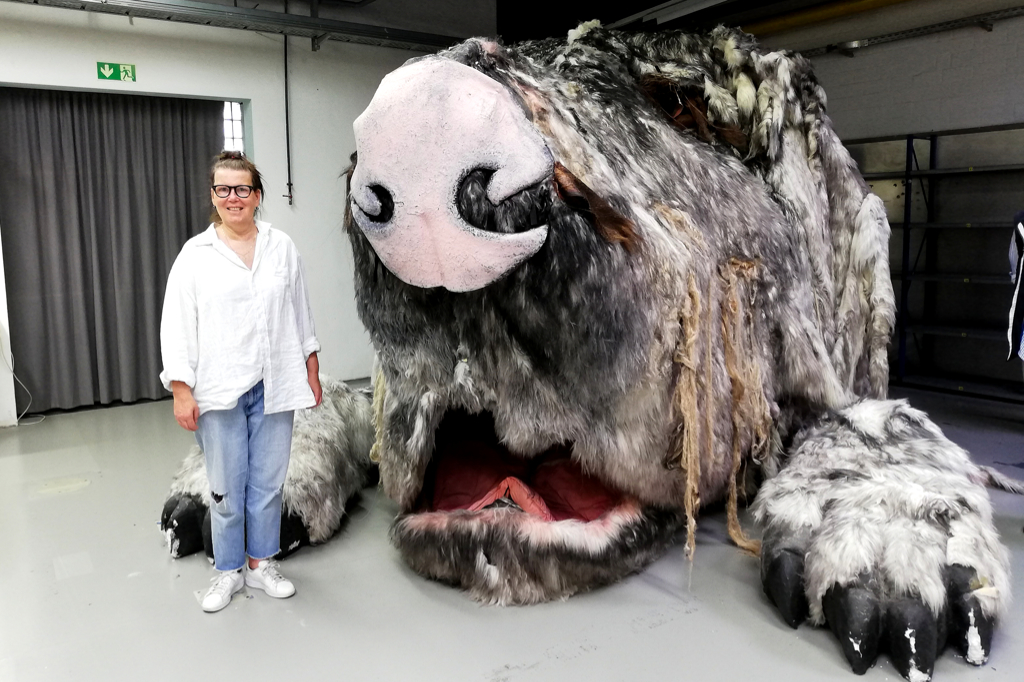
As a matter of fact, he has to find a new home real quick since otherwise he will be shredded. I live in a two-bedroom apartment. There’s definitely no space for a Moondog. Still, I feel bad that I had to leave this creature in need behind.
Hafenstraße 76
In the past, Kassel used to have an industrial port that was used for freight. Since 1977, however, this harbor has been used by the local yacht club. Therefore, many of the old industrial houses aren’t used any longer. Also, the multi-storey building constructed in 1907 at Hafenstrasse 76 stands empty.
Today, the Berlin-based collective Fehras Publishing Practices is shooting its fictional photo novel called Borrowed Faces here. Actually, it’s pretty hilarious and my absolutely favorite work at this venue.
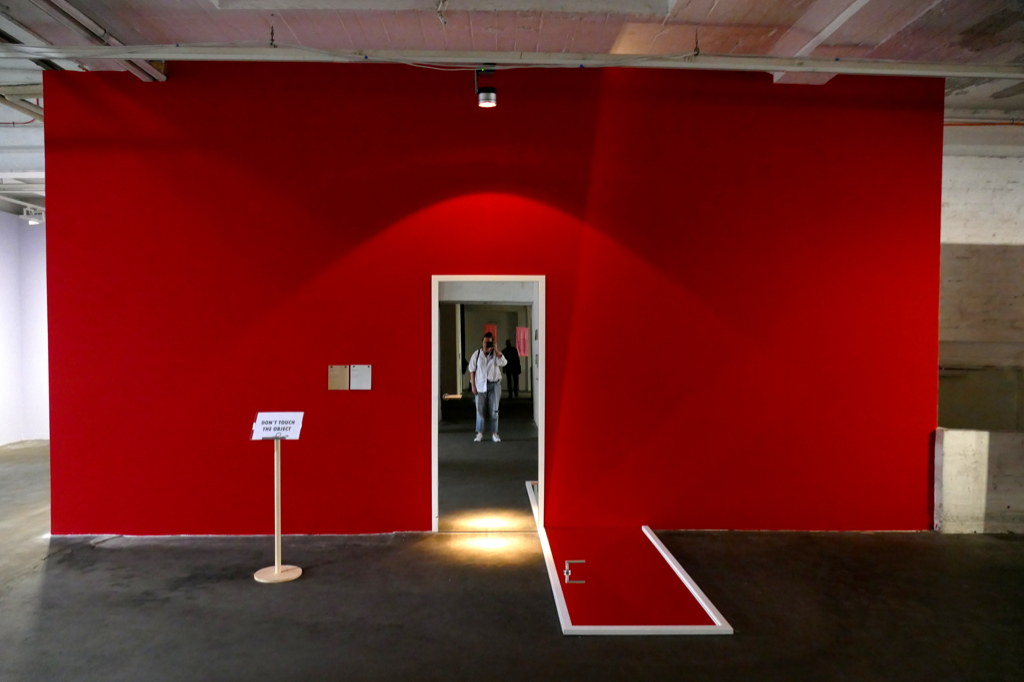
On the ground floor are screenprints and hand-painted silks by graphic artist Nino Bulling. Also, the foundationClass collective transformed parts of the ground floor into a communal space.
My personal problem with the other works at the Hübner Areal was that they were extremely participative and educative and you really needed to take your time and immerse yourself in the projects. It was late. I was tired. I didn’t even want to think anymore, I just wanted to let the show wash over me.
There comes a moment when even a culture vulture just hangs her wings.
Plan Your Visit
When to Go
In 2022, documenta fifteen is taking place from June 18 until September 25. The regular opening hours are every day from 10 a. m. to 8 p. m.
Especially on weekends and public holidays, it tends to get really busy so that at some of the venues, you might have to queue for a while. Therefore, I’d definitely recommend visiting during the week if possible.

A good time to visit is during the German school holidays from mid of July to mid of August. Not only are most people on vacation. Also, you won’t run into hordes of bored students on field trips.
I’ve spent two whole days in Kassel and managed to get to all venues. If you want to immerse yourself – which is actually the concept and philosophy of this year’s documenta – you need at least three days. There are many spots where visitors are supposed to hang out and meet and get united. Also, there is a broad program of music and performances so I cannot really say when enough is enough. For me as a non-immersive visitor, my two days were dense and busy but fine.
Which Ticket to Buy
In comparison to other art events like the Biennale di Arte, the documenta is ridiculously overpriced. But since we won’t be able to change that, I’m just listing the prices below, thinking ouch! every time I write down the figure:
A general ticket for one day costs 27 €uros, for two consecutive days 45 €uros. However, you can pick the first of those two days freely. Also, those tickets include free use of regional public transport. Albeit, while there is the 9 €uro ticket option in place, this perk is rather pointless.
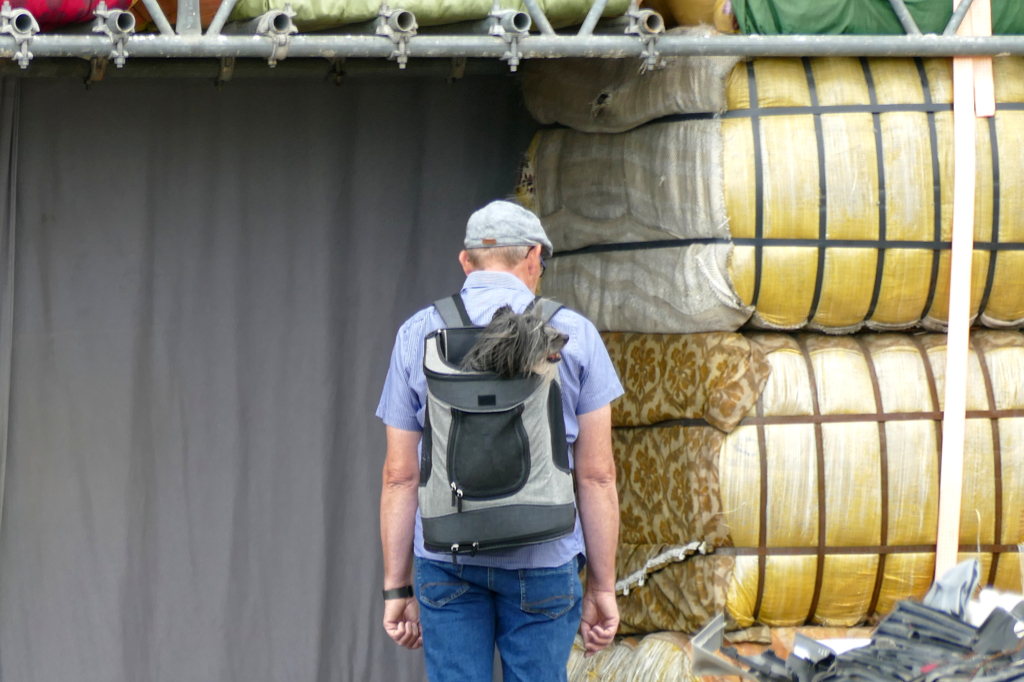
Obviously, there is also a personalized season ticket that sets you back 125 €uros. Evidently, this pass does not include free use of public transport. Nevertheless, those ticket holders can purchase discounted MultiTickets while the documenta is on.
The best way to obtain tickets is on the documenta’s webshop. However, you can also obtain them only on the spot.
How to Get There
Flight
The city of Kassel has a rather small commercial airport. If you don’t want to take a cab, bus #100 takes you to the city center in about 40 minutes. However, there’s only one coach per hour.
Train
Kassel is located in the middle of Germany. I’m sure that every German who has ever taken a train had to pass through Kassel a couple of times in his or her life. Hence, connections to many cities in Germany are frequent and quick: it’s about 90 minutes to Frankfurt and about 3 to 3.5 hours to either Hamburg, Berlin, or Munich, to name just a few.
You can check timetables and prices on the website of the Deutsche Bahn, Germany’s national rail company. It’s available in eight languages.
There is one curiosity you should be aware of when travelling to Kassel: The Hauptbahnhof, hence, the main train station, is actually not the main hub and is frequented only by regional and local trains. The more important train station is named Kassel-Wilhelmshöhe and is located about 7 kilometers west of the city center. Nevertheless, there are many regional trains as well as trams connecting the city center with this station.
June to August 2022
Due to the high energy and fuel prices, the German government agreed on a relief package for all citizens. Among other measures, it includes a so-called 9 €uros ticket. With this ticket, you can travel throughout Germany for the entire month of June, July respectively August.
That’s absolutely amazing, however, there are some minor strings attached. The 9 €uros ticket is only valid within Germany and exclusively in local and regional means of transport. Hence, the Eurocity, Intercity, and Intercity Express trains are excluded. However, you can use regular buses, trams, subways, and suburban trains as well as regional express trains for one month for 9 €uros all over Germany. In Hamburg and Berlin, you can even take ferries.
While the 9 €uros ticket is valid throughout Germany, it is not linked to German citizenship. Therefore, foreign visitors to Germany can use the 9 €uros ticket, too. Keep in mind that children under the age of six travel for free, anyway.
Bus
Flixbus is conquering the world – at least the world’s European part, hence it’s also serving Kassel. It might not be the fastest way to travel, but it’s quite comfortable and definitely the cheapest. For instance, a one-way trip from Frankfurt sets you back only about 15 €uros and takes almost 3 hours.
However, there is also the so-called Flixtrain between some German cities. It takes you from Frankfurt to Kassel in 1.5 short hours for about 15 to 20 €uros. The connection between Kassel and Berlin takes 3 hours and tickets start at around 20 €uros. However, while the bus rides are okay, the trains tend to be quite unreliable.
The bus station is on Bertha-von-Suttner-Straße west of the train station Kassel Wilhelmshöhe. You can get there by city bus line #52 from the main station.
To check schedules and prices, visit their website.
How to Get Around
Public Transport
In general, one trip within the city limits costs 3 €uros. Short distance trips that included three consecutive stops in total cost only 1.90 €uros. Youngsters under 18 years of age pay 1.90 €uros for a general ticket.
There are also 5-journey tickets, day tickets, group tickets, and much more. You can check out your best option on this website.
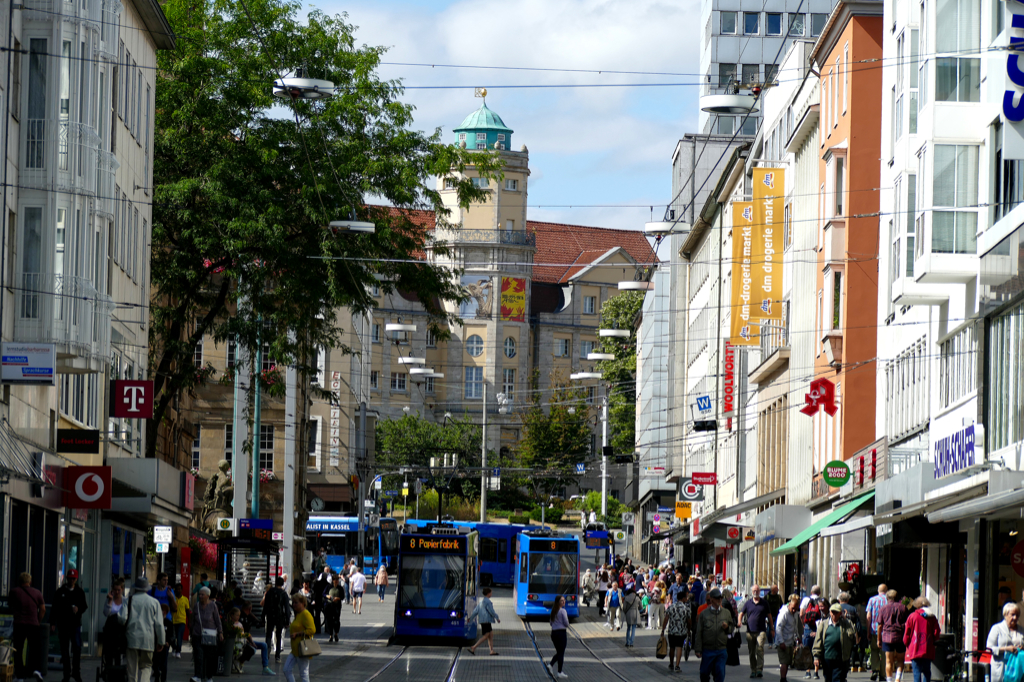
Nevertheless, keep in mind that tickets are only valid if they have been stamped before departure. Even if you have a ticket, if it’s not validated, you might be fined.
Except for short trips, you can change means of transportation as you like as long as you travel in the same direction without pauses and obvious detours. Hence, no round trips and return trips – except with day tickets, obviously.
If in summer 2022, you have obtained a 9 €uro-ticket, you have unlimited use of local public transportation in Kassel for that particular month.
I don’t know why it is, but Google maps doesn’t cover the public transport in Kassel in a helpful way. For instance, they completely ignore the trams which are the most comprehensive and important means of public transportation within the city limits. However, on the free documenta map, you’ll find the trams that are connecting the venues. Usually, they go every 15 minutes, but you can check the schedules on the KVG’s website.
Shuttle Between Venues
All documenta venues in Kassel can be easily reached by bus or tram.
Also, the local public transportation company KVG has installed a bus route. A shuttle bus runs daily between 9.30 a. m. and 8.30 p. m. every 15 minutes.
However, free use of all public transport in the Greater Kassel region is included in your documenta ticket. Obviously, it’s not included in the season ticket, but ticket holders can still purchase discounted MultiTickets during the documenta.
Cycling
Another convenient way to explore Kassel is by cycling. The local bike rental company is called nextbike and you find their website here.
Registration is free, however, you need to create an account with a starting credit of 1€uro. Then, you can pay by credit card, debit, your mobile phone account, or PayPal. For a monthly fee of 10 €uros, you get 30 minutes per rental free. Since Kassel is not that big and you can leave your rental bike at many different stations around town, you probably won’t pay more than your monthly fee.
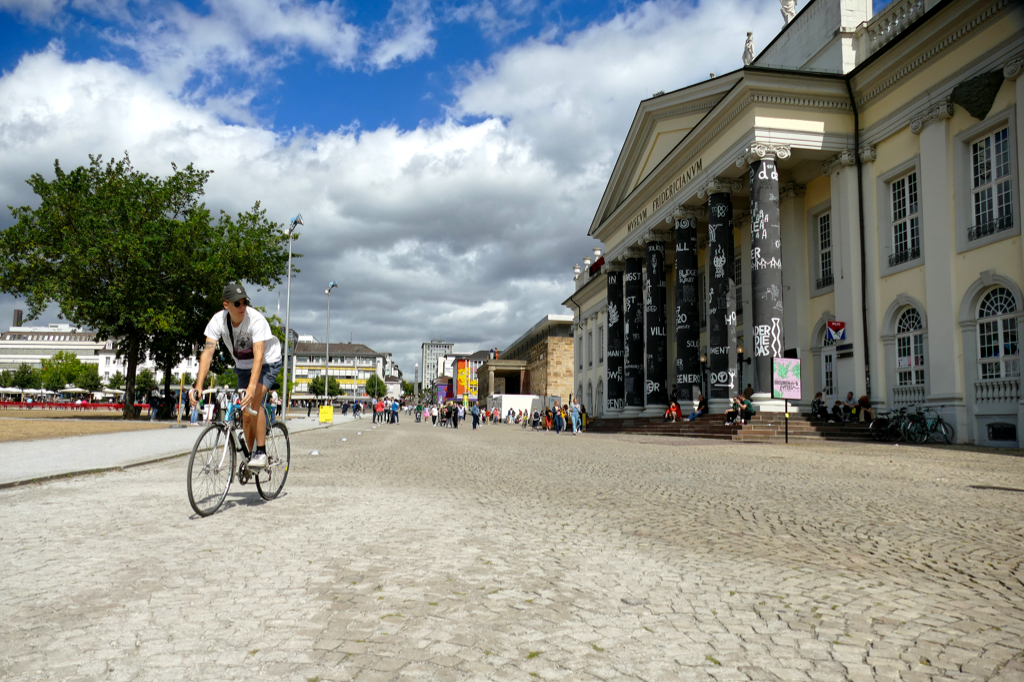
However, if you do not want to pay a monthly fee, the rate is 1 €uro for 15 minutes. Therefore, I presume that even if you’ll explore Kassel cycling for only one day, paying the monthly fee is far better.
Where to Stay
Normally, Kassel is not very touristy. However, during the international mega event documenta, rooms get far more expensive and still tend to sell out. Therefore, you should book your accommodation as early as possible. On this map, you’ll find some reasonably priced lodging options*:
Booking.comWhere to Eat
Since the documenta is such a collective event this year, there are also many communal areas where you can get drinks and snacks. Obviously, you won’t find a great bargain here, but actually it’s not too bad.
Across from the Fridericianum, for instance, is a row of different food trucks selling all kinds of high-quality fast food.

But you’ll find eateries and bars at basically each of the venues.
Some Extra Tips
After having been to several editions of the documenta, I’m happy to share some tips that will make your visit less stressful:
1. Walk as little as possible
Don’t get me wrong, I’m an avid walker. On city breaks, I walk miles and miles. However, you’ll walk those miles even if you try to walk as little as possible. Therefore, you should refrain from thinking, oh, it’s only two kilometers, that’s not too bad, why wait for the tram, I can walk that. Yes, you obviously can. But if you do this the whole day, you’ll be dead in the evening. Believe me, all those assumably short walks add up quickly.
Also, don’t let the bus or train schedules fool you. Even if places are only two stops apart, this can be a considerable distance. Kassel’s means of public transport do not stop at every street corner.
You won’t be exactly lazy even if you avoid walking wherever you can.
2. Wear comfortable, sturdy shoes and cozy, loose clothes
After having explained above how much you’ll automatically have to walk, it should go without further explaining why you have to wear comfortable shoes. It won’t hurt – literally – if you even opt for hiking boots.
As I explained, this documenta is very participative. It’s not like visiting a gallery. There are screening rooms where you have to sit or lay on carpets or beanbags. You’ll climb stairs in abandoned buildings, visit makeshift tents, and cross wild gardens. If this sounds like visiting some kind of adventure playground, I did a good job in describing it. So don’t even think about putting on a pencil skirt or your Sunday suit. I wouldn’t go so far as to recommend wearing dungarees but put on some comfy old jeans and you’re good to go – but also sit and lounge.
3. Don’t bring snacks or too large water bottles
Usually, I’m the first to recommend carrying lots of water when visiting an art festival. There are few stands, lines are long, and prices are high. Well, this is not the case at the documenta. First of all, many of the venues are located in the city center right next to supermarkets and convenience stores. Hence, as soon as you get thirsty, you can buy a small bottle of water at a really cheap price. But even if you take a break at one of the many, many bars and cafés that you’ll find at practically each one of the participating venues, it won’t burn a hole into your wallet.
Don’t make your visit harder by schlepping provisions for the whole day.
4. Leave as much as you can at the cloakrooms
This being said, note that there are a couple of provisional cloakroom set up in the vicinity of various venues. They are free of charge and open till 8 p. m. This way, you can happily leave everything you don’t urgently need on you behind. Even if you happen to need something from your bag, you can always go back and take it out.
Apart from my small backpack, I had a tote with me. This way, I took only my wallet, my phone, and my camera with me and picked up the rest of my stuff only in the evening.
These cloakrooms are a fantastic service to the visitors.
5. Look also beyond the documenta
As I said, within two days, I got to visit all designated venues. And while I wasn’t just racing from spot to spot, I could have spent more time at some places. Also, my retentiveness decreased over the day. At the end of the day, I was like yeah, whatever. Visiting an event like the documenta is not only exhausting for the body, it’s also tiring for the mind.

But how does it make sense to recommend even more places to see? Well, I find it quite refreshing to visit some places that don’t have to do with the documenta. It’s like emerging in the real life. Kassel is really nice and I would recommend spending the night for instance in the Nordstadt neighborhood. This way, you can have breakfast at one of the trendy cafés, watch people walk by, admire the Gründerzeit architecture, and spot some streetart.
It’s refreshing to take a break from your art break.
Map
On this map, you get an overview of where all these wonderful works can be found. Clicking on the slider symbol at the top left or the full-screen icon at the top right will display the whole map including the legend.
Pinnable Pictures
If you choose to pin this post, please use one of these pictures:

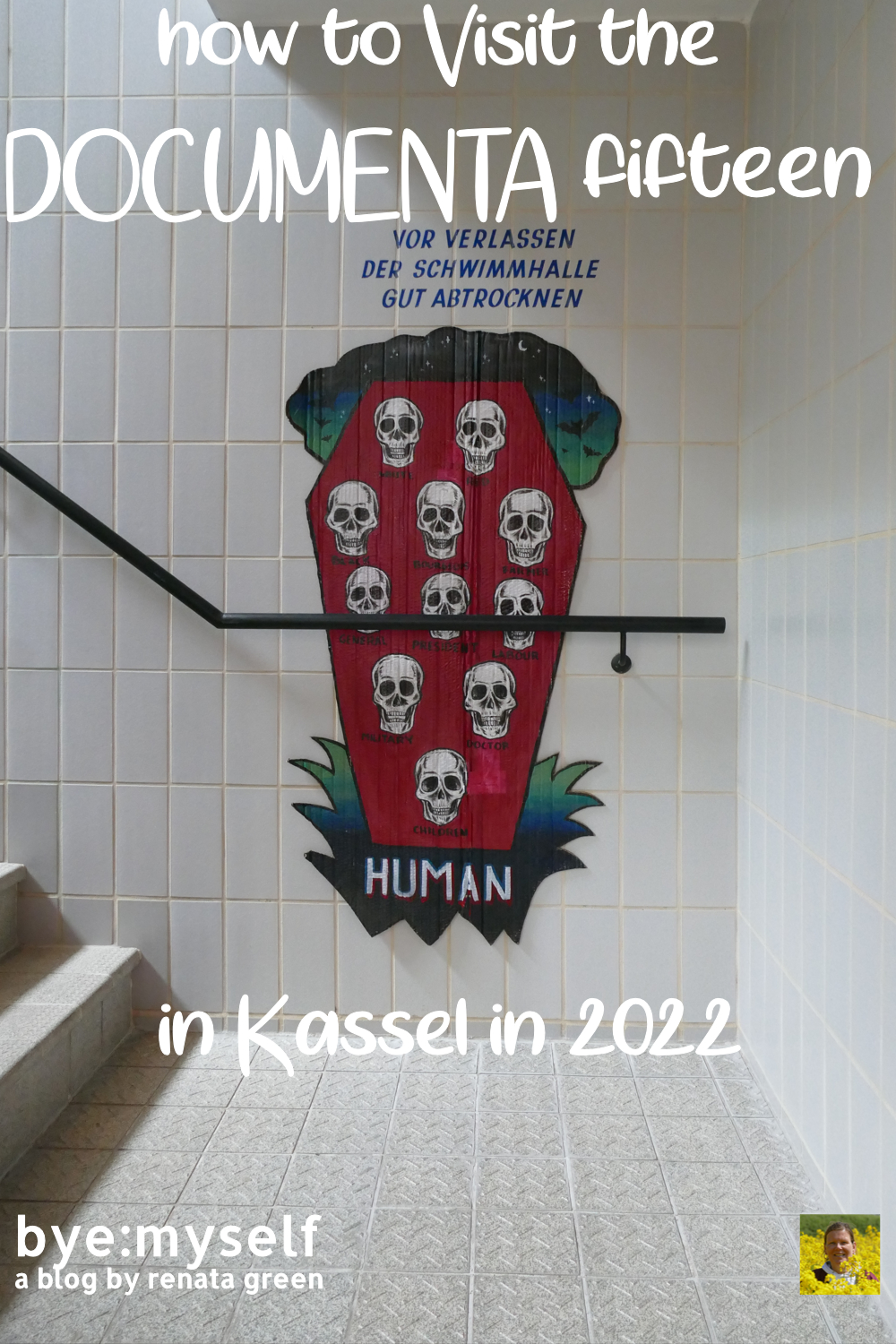
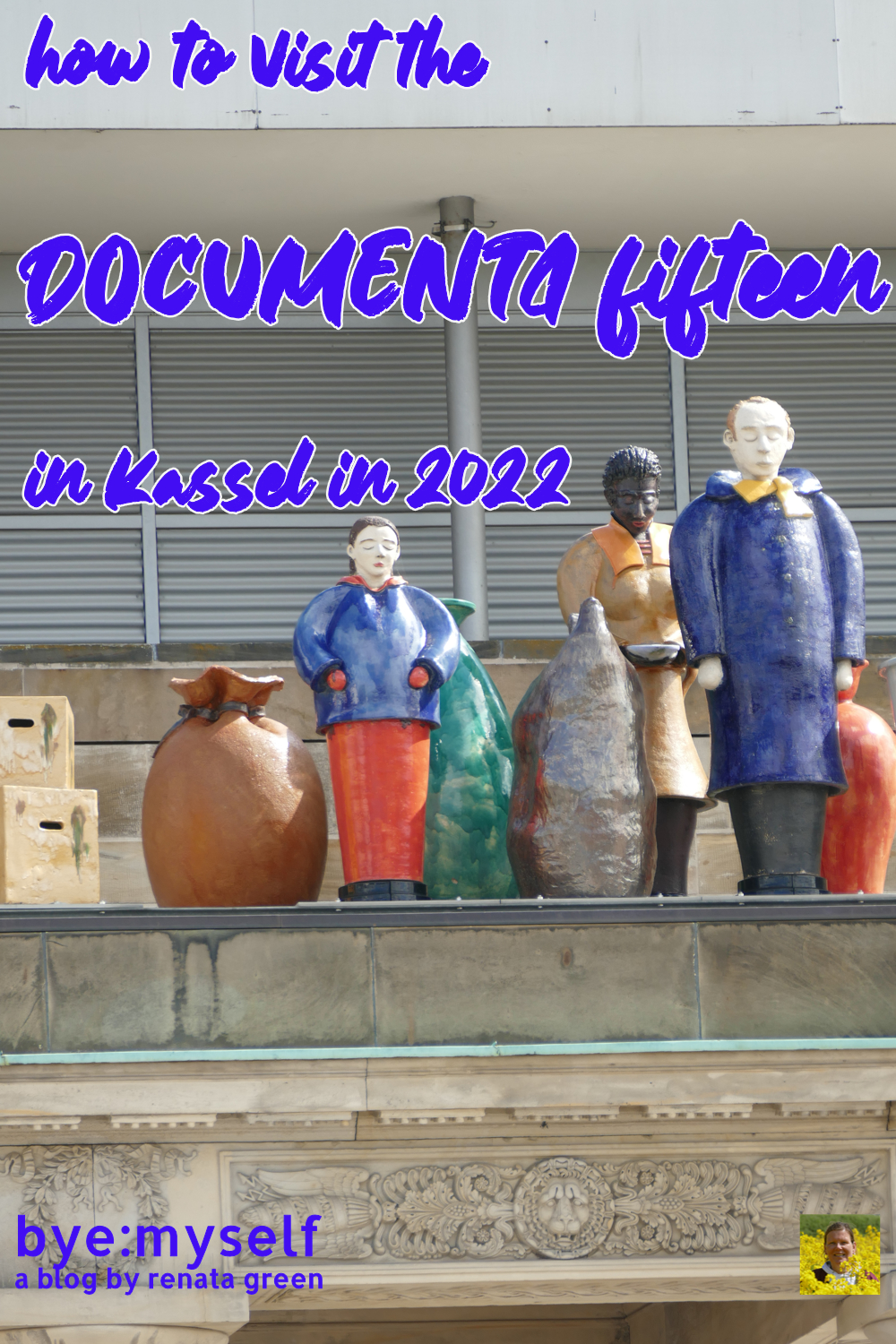
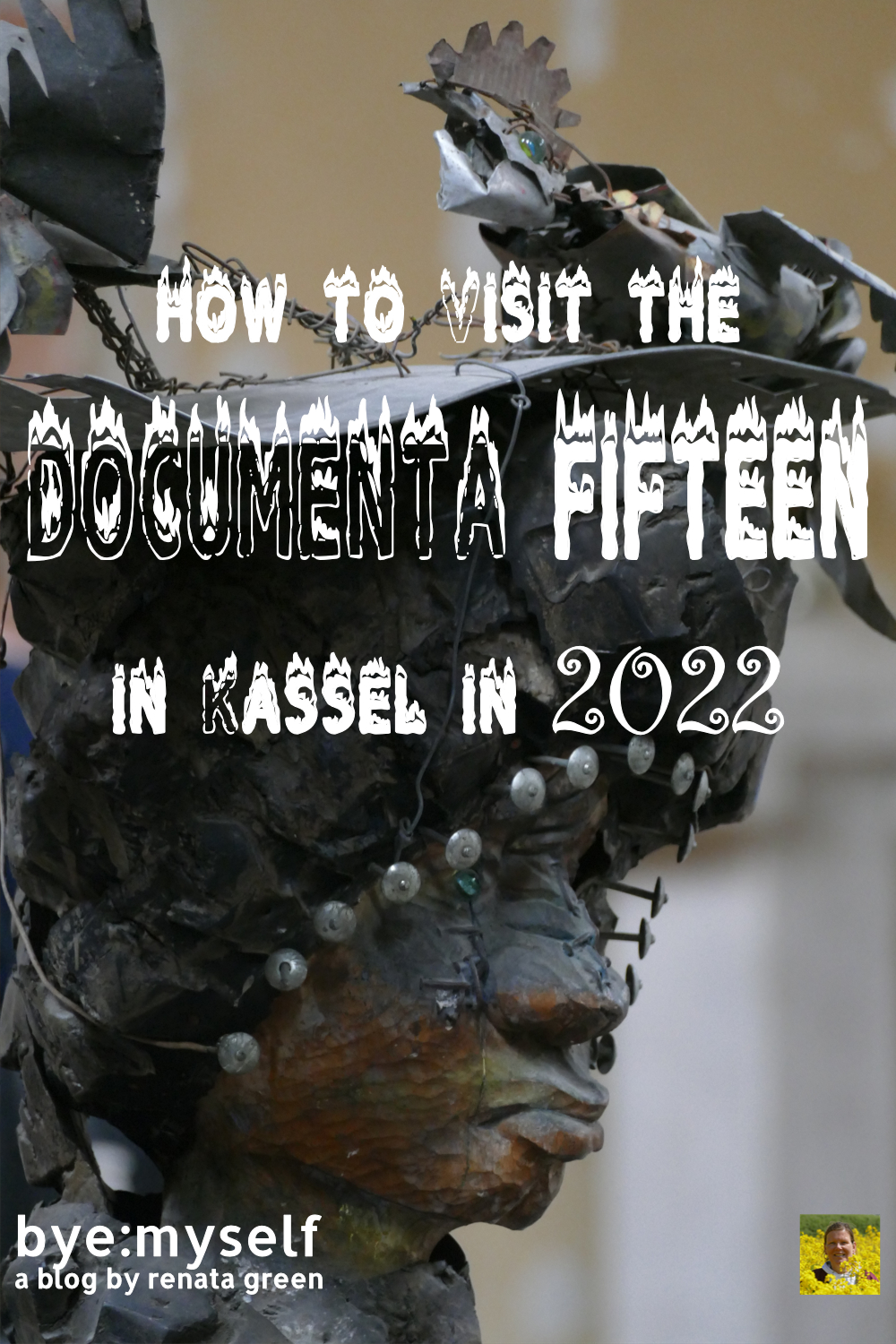

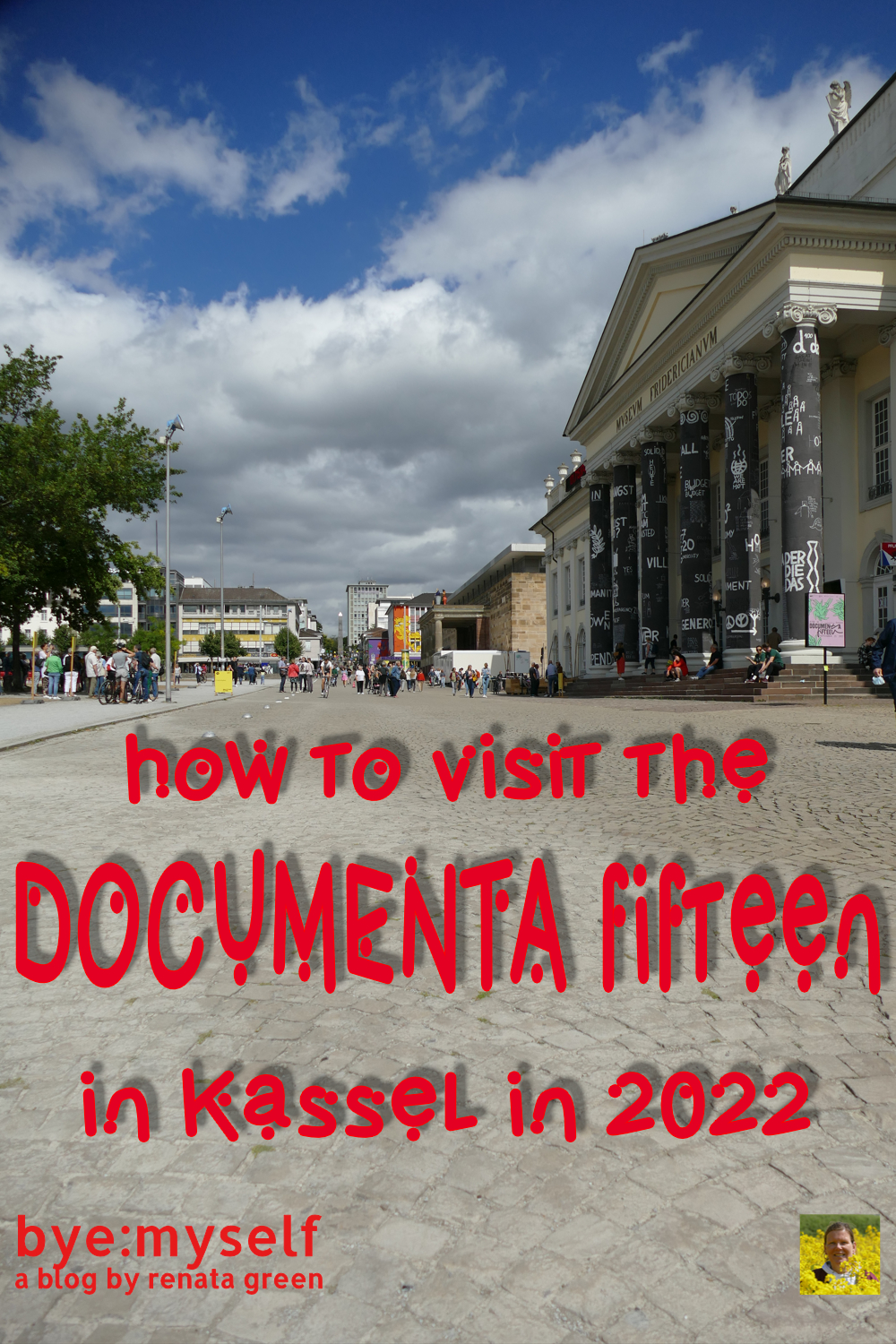
Did You Enjoy This Post? Then You Might Like Also These About More Art And Art Events:
Weekend in VALENCIA. Ten Reasons Not to Miss Out on a Visit
INCHEON – Best Things to Do in Korea’s Only Chinatown
A Visit to the Colonia Güell – Where Eusebi Güell Created His Universe
Best Street Art in PARIS: How Mehdi Ben Cheikh Transformed the 13th Arrondissement Into An Open-Air Gallery
INHOTIM Botanic Garden and Gallery
most instagrammable – till death do us part: a rant
The Best and Most Beautiful Beaches of Naxos
JIDAR Street Art Festival – How Rabat Celebrates International Urban Art
* This is an affiliate link. If you book through this page, not only do you get the best deal. I also get a small commission that helps me run this blog. Thank you so much for supporting me!
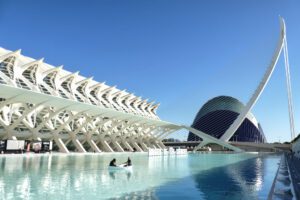
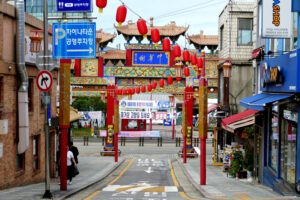


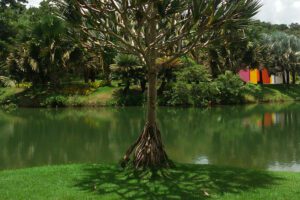
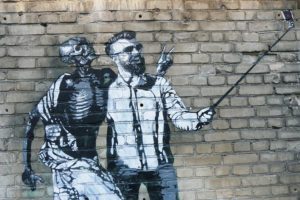


I have not heard of DOCUMENTA fifteen in Kassel before. An excellent guide to this cultural event, with many exciting exhibitions and events! The museum for Sepulchral Culture seems fascinating. Also, the exhibition in St. Kunigundis Church looks so exciting. Great tips on how to plan a trip!
The exhibition of Haitian art at the church was my favorite part 🙂
Yes – thank you for the comprehensive and fun guide to the Documenta! Love it!!
Glad you like it. I recommend to check out my post on the other art events that are taking place this year 😉
So much art, so little time! You covered so much that I wouldn’t know where to begin! Amazing displays of art…I do hope the dog finds a home though. 😊
Hahaha – me too! 🙂
Wow – you managed to see a lot during your 2 days at the DOCUMENTA. We also visited the exhibition, but to be honest, we were a bit lazy. I felt that most of the art was not easilay accesible and that I would need a lot of background information in order to find them interesting. But I enjoyed the DOCUMENTA and my favorite were the low-budget movies from West Africa.
I totally agree! And since there is so much to see, I just didn’t have the patience to read all the info. I’m afraid I didn’t dig deep enough at certain spots, but ¯\_(ツ)_/¯
Great post! It was so great to learn about so many different modern works of art from so many different unique perspectives. Would love to visit.
That’s great 🙂
Fascinating, I’ve heard of Venice and Basel so Kassel and Documenta is very new to me and quite an elaborate celebration of modern art and concepts. I love seeing all the outdoors venues and street art as well for this type of experience so it encompasses the everyday in Kassel as well as an international celebration of modern and fine art.
Yes, it’s a truly immersive experience 🙂
You are certainly having an arts-filled year. The Documenta in Kassel sounds like an amazing spot every time years when it glitters for 100 days. I too am more of an admirer. A paint brush only works for painting walls for me. You certainly saw an interesting variety in the art pieces. The cauliflower exploding from a gun made me stop. I can see you will be waiting for tickets for the next time the show happens.
Yap, the message is clear: food can certainly be a weapon 😀
Wow! This is such a useful guide. It amazing that they do this every 5 years. What an cultural experience. There is so much to see and take in with the variety of art exhibits. I like how they have made this into an interactive and used technology as a way to learn about the different installations, like the FAFSWAG collective. Not sure how I would feel seeing the ghostly dancer appearing on my iPad.
Yes, it’s definitely a different kind of art show.
I guess I’m not into art as I never heard about this Documenta. But as Indonesian, I’m proud that the documenta 15 will be curated by RuangRupa, a group of artists from Jakarta, Indonesia. Salute and good luck to them!
There are many Indonesian artists participating this year – you’d be so proud 😉
It’s rare to find good reviews of the documenta, but you seem like you know what you’re talking about! Thanks!
Glad you like my post.